Poster Day 2016
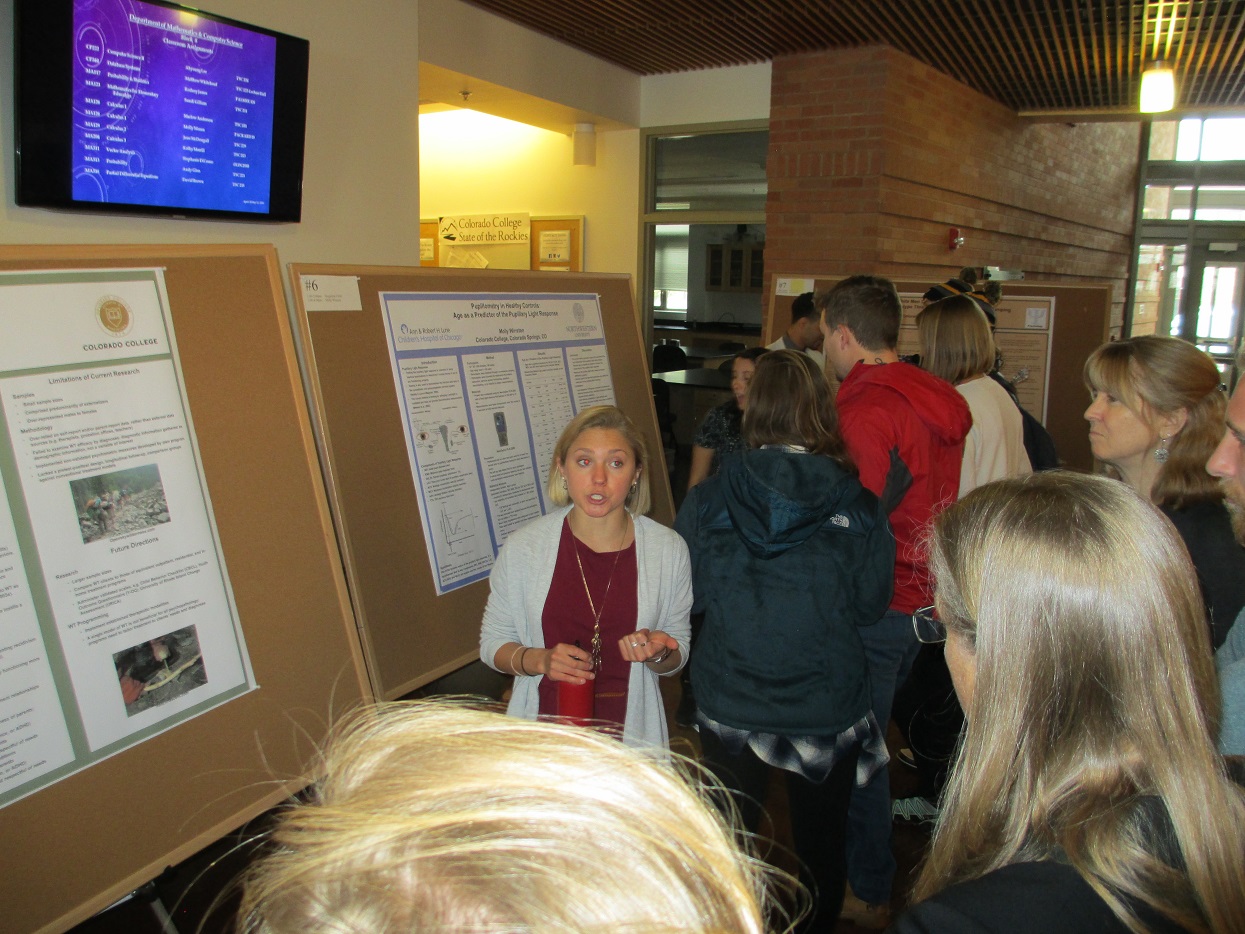 Samantha K. Buxbaum
Samantha K. Buxbaum
Psychology
Advisor: Tricia Waters
Wilderness Therapy: Truly Effective?
This paper examines the empirical research on the efficacy of wilderness therapy and for whom wilderness therapy is most efficacious. The largely anecdotal and quasi-experimental designs of current research limit the reliability and generalizability of these studies' results. However, their suggestive findings can lead to more systematic work. This paper focuses on clients with externalizing (e.g. behavioral problems such as violence, delinquency, substance abuse, and oppositional defiant disorder) and internalizing behaviors (e.g. depression, anxiety, and self-harming behaviors). Externalizers seem to benefit more from wilderness therapy than their internalizing counterparts. Gender, family relationships, and parental involvement in wilderness therapy also appear to significantly influence the effect of wilderness therapy on mental, emotional, and social health.
Tessa Carroll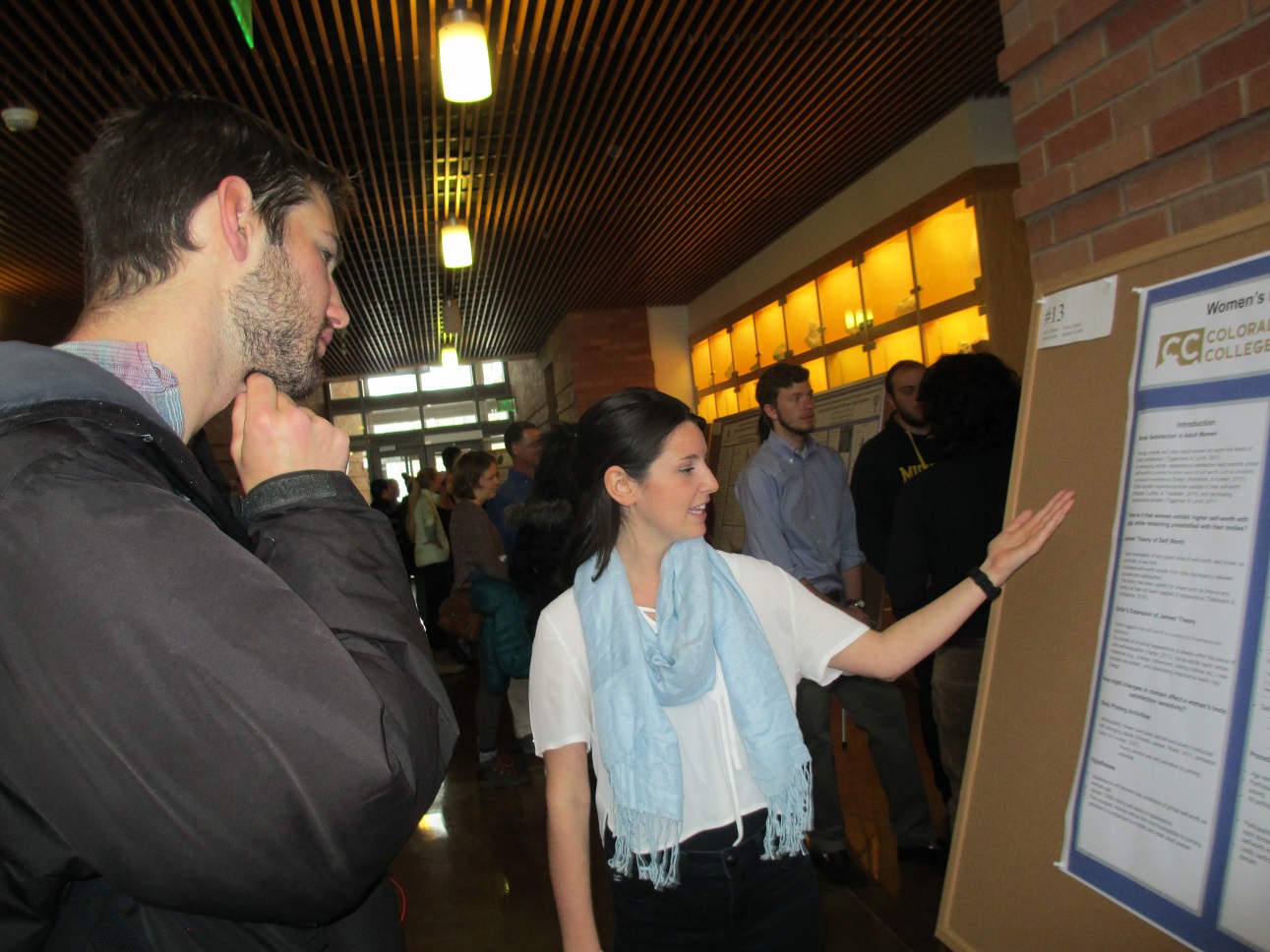
Psychology
Advisor: Tricia Waters
Women's Development: The Relationship Between Appearance and Self-Worth
Appearance and self-worth are often inextricable for emerging adult women. Young women place a great deal of importance on appearance, and it is an incredibly sensitive construct. However, the importance of appearance and its sensitivity has not been researched for middle and older adult women. Within a large body of research a paradox has arisen; women of all ages tend to be dissatisfied with their appearance, yet self-worth tends to stabilize and increase with age. This developmental change is the major concern of this empirical study. By use of a Jamesian framework of importance and success, and priming activities, the current study unearths that older women tend to place less importance on appearance, appearance decreasingly predicts self-worth, and because of this, appearance is generally less sensitive to external influences such as negative or positive body primes.
Daphnée Narée Chabal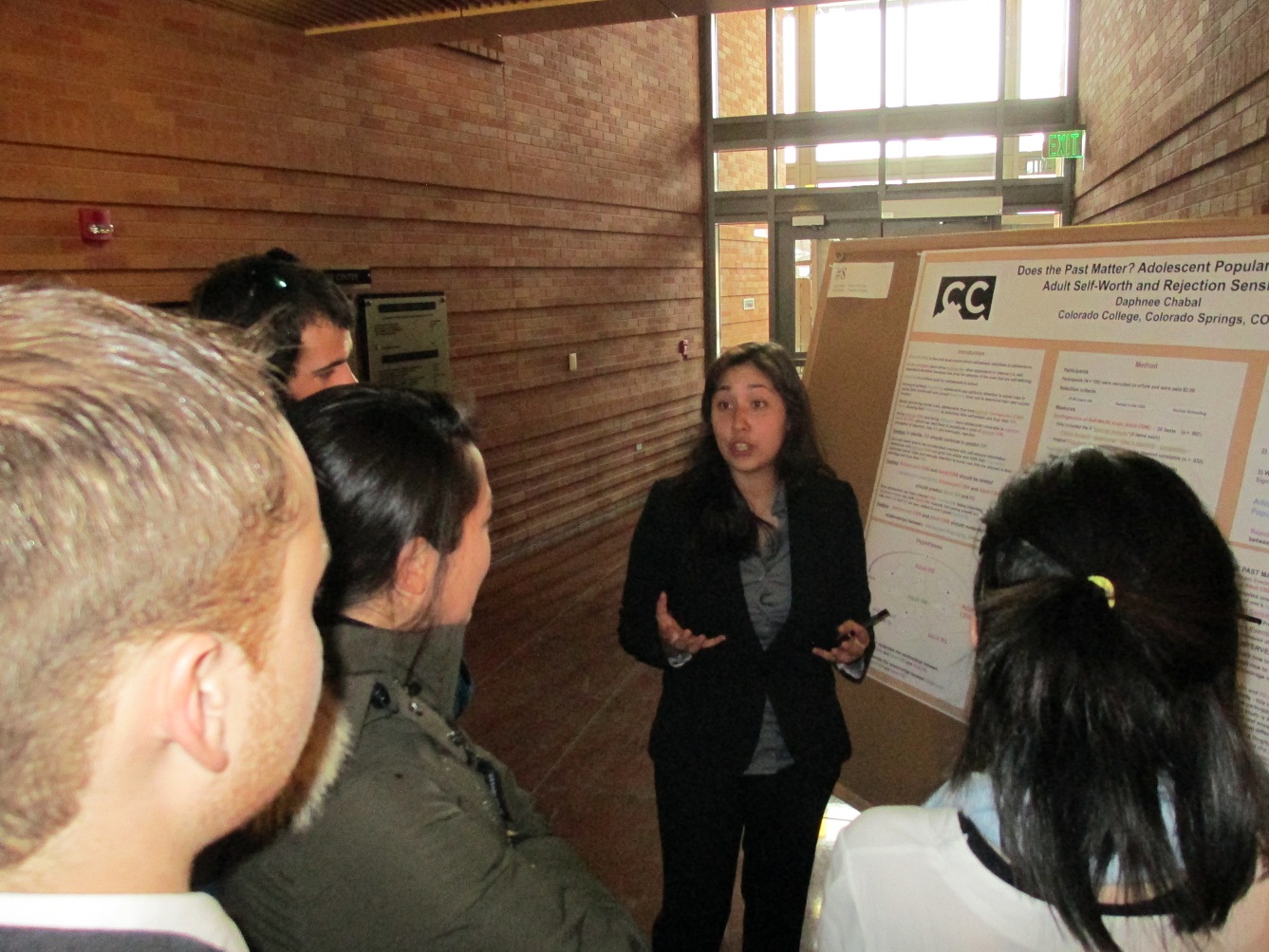
Psychology
Advisor: Jason Weaver
Does the Past Matter? Adolescent Popularity Predicts Adult Self-Worth and Rejection Sensitivity
When people enter preadolescence, others' evaluations of oneself inform one's sense of self and self-esteem. Adolescent self-worth (i.e. the trait level around which state self-esteem fluctuates) is contingent upon social domains of self-worth (CSW), others' approval, one's appearance, one's competitiveness, and the amount of support from one's family. Not only does adolescent popularity predict adolescent self-worth but it also predicts adolescent rejection sensitivity. Because self-worth and its contingencies are stable constructs that are consistent overtime, this study hypothesized and found that adolescent popularity predicts adult self-worth (SW) and adult rejection sensitivity (RS), and that both adolescent and adult social contingencies of self-worth predict SW and RS. Significant life events did not impact these relationships. However, both CSW scales were not significant moderators of the relationships between popularity and SW and RS. This later finding and the durable influence of adolescent popularity on SW and RS are discussed, as well as the implications of this study. The need for future research to rely less on scales that involve self-report and to consider a longitudinal design is also discussed.
Jacqueline E. Child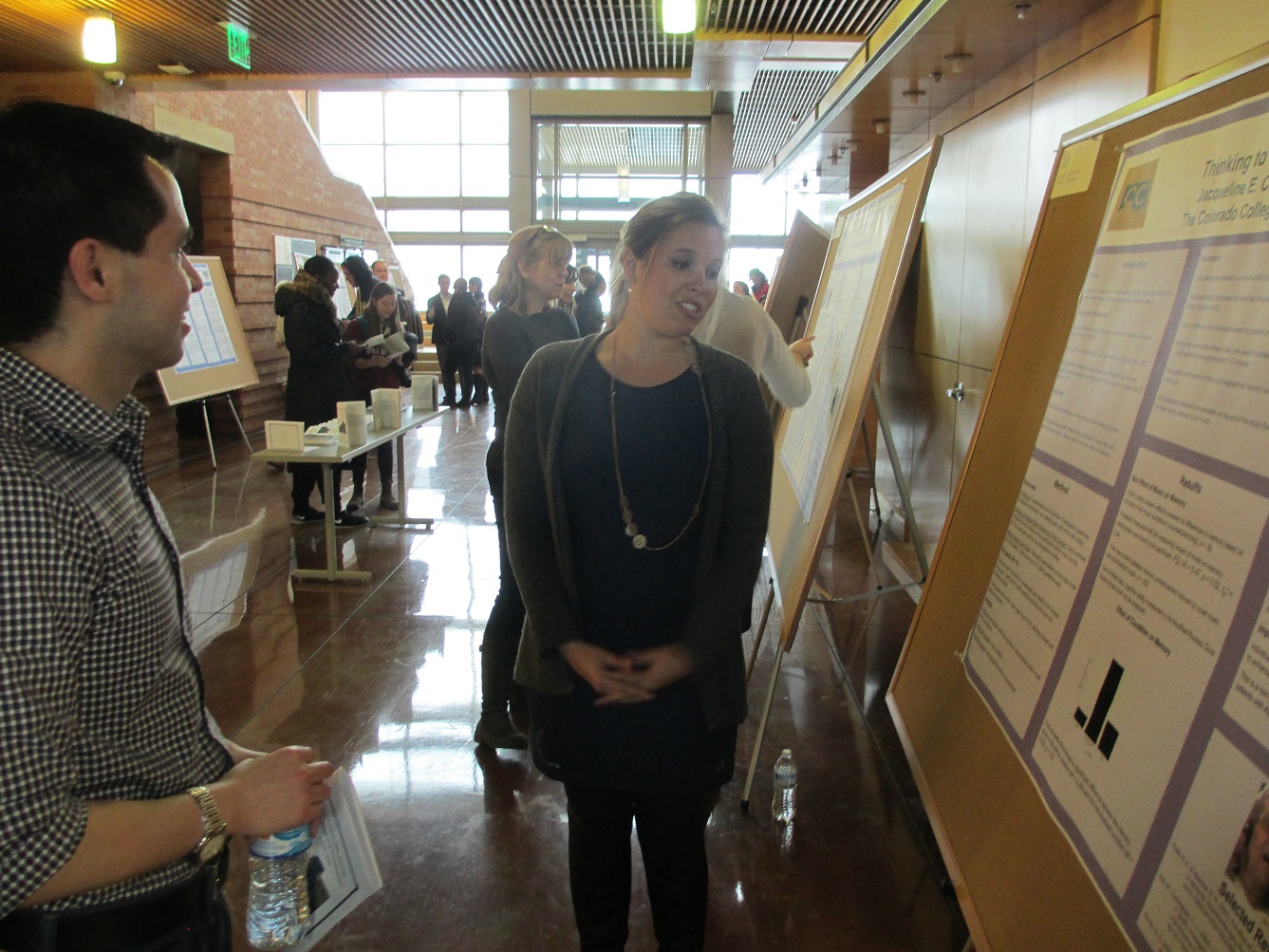
Psychology
Advisor: Tricia Waters
Thinking to the Beat of the Music
Dementia (and all dementia related diseases) attacks the brain and causes a decline in autobiographical memory. Given the severity of the disease, it is imperative to find new ways to ease the pain and suffering associated with this neurodegenerative illness. This study investigated the effect of music on dementia patients' recall of autobiographical memories. Eight patients with Alzheimer's disease were studied in order to understand the effect music has on people with neurodegenerative diseases. Music can trigger the recall of personal memories, though research suggests individualized music leads to the most memory enhancement. There was a significant difference between memory enhancement of the participants in the silent condition compared to the individualized music condition suggesting that listening to music.
William Cohn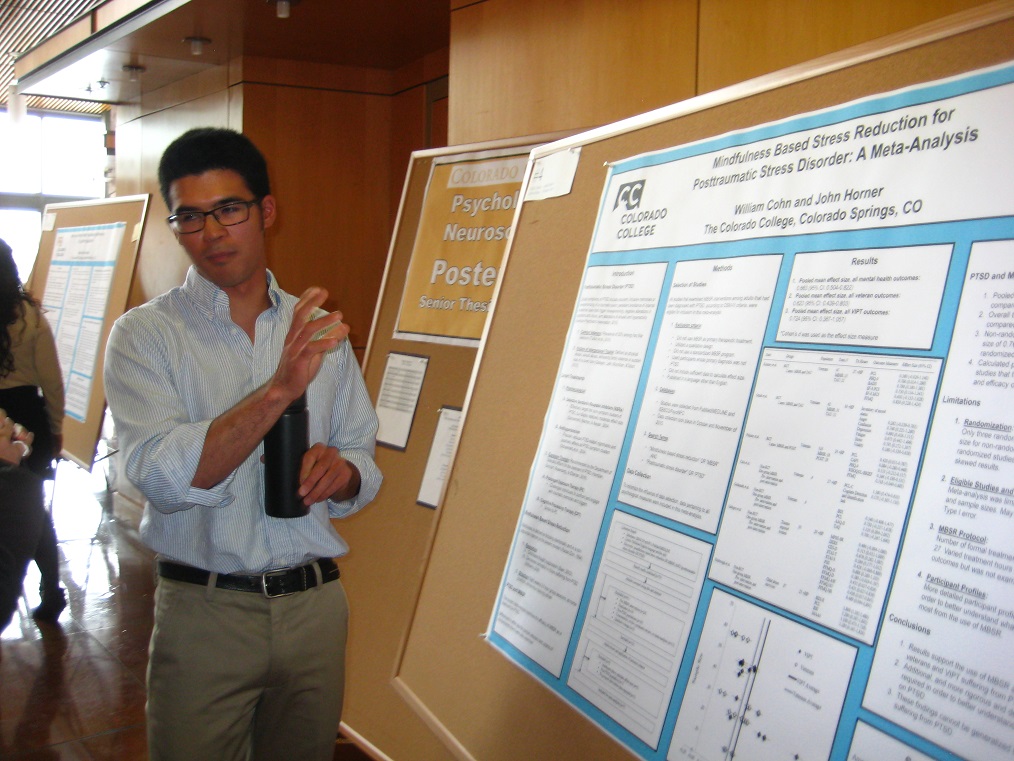
Neuroscience
Advisor: John Horner
Mindfulness Based Stress Reduction as a Treatment for Posttraumatic Stress Disorder: A Meta-Analysis
A meta-analysis was conducted to determine the efficacy of Mindfulness-Based Stress Reduction (MBSR) as a treatment for Posttraumatic Stress Disorder (PTSD). A search of PubMed/MEDLINE and EBSCO/PsycINFO yielded 73 possible studies, seven of which were included in the final analyses. Of these seven studies, five examined the effects of MBSR for PTSD in veterans while two examined similar effects in victims of interpersonal trauma. The pooled mean effect size was moderate to large with non-randomized studies showing a greater overall effect compared to randomized studies. Victims of interpersonal trauma also displayed a greater effect size compared to veterans. The overall observed trend, seen in the created funnel plot, also indicates that MBSR is more effective for victims of interpersonal trauma, compared to veterans. Future research is recommended but should utilize active control groups, a standardized form of MBSR, and should report more detailed demographics of its participants.
Spencer K. Cooke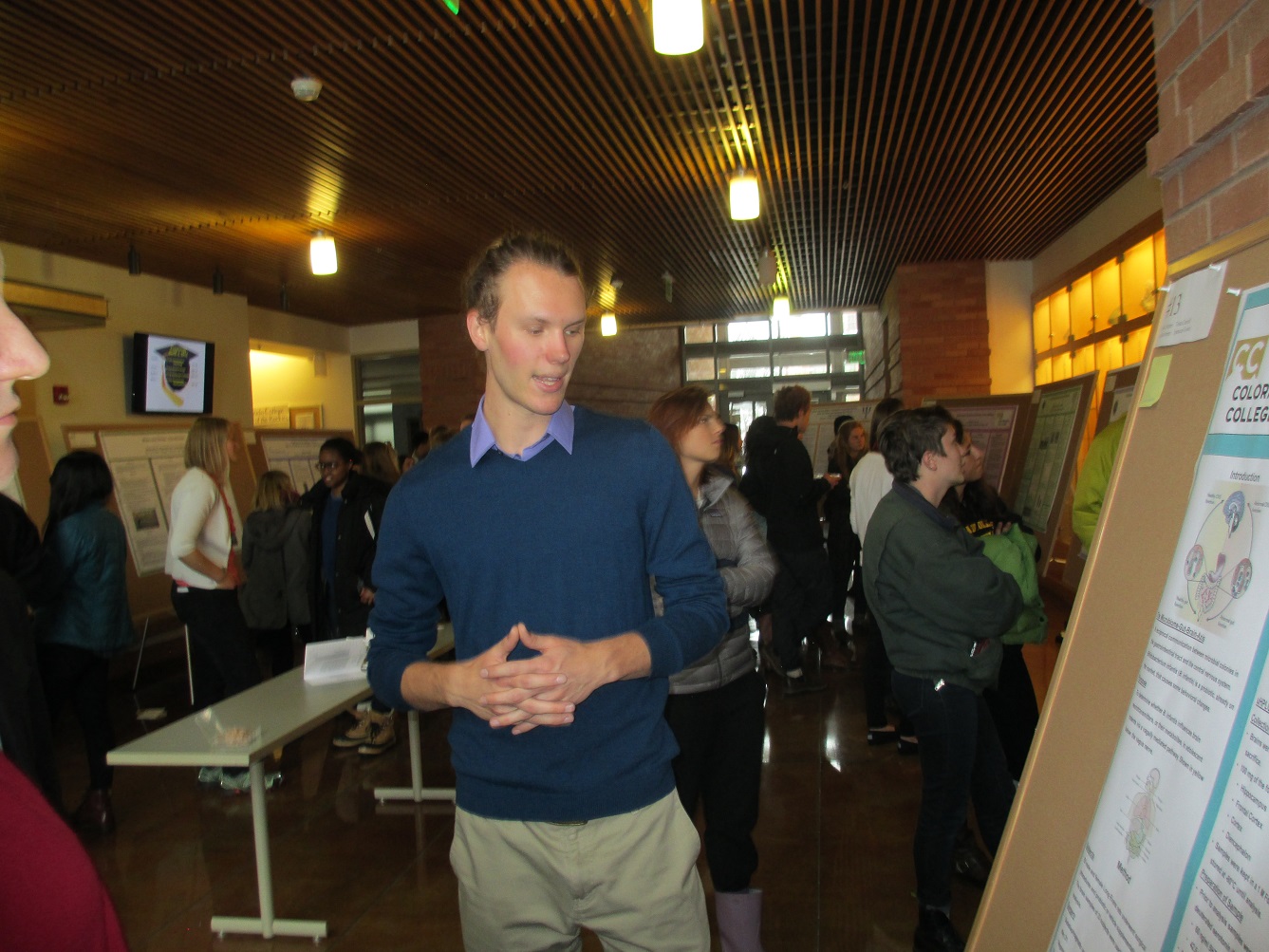
Neuroscience
Advisor: Lori Driscoll
Vagal Mediated Effects of Oral Bifidobacterium infantis Supplementation on Brain Neurotransmitters in Adolescent Rats
Recent studies are beginning to show the complex interactions between microbes living in the gastrointestinal tract (GI) and the central nervous system (CNS); this system of communication is known as the gut-brain axis. Beneficial gut bacteria, called probiotics, can provide health benefits to the host via neurochemical, hormonal, or immunological signaling. For example, probiotics and other GI bacteria utilize the vagus cranial nerve as a major relay to the CNS. The current study set out to explore the effects of oral supplementation in adolescence of a probiotic, Bifidobacterium infantis (B. infantis), on serotonin and 5-hydroxyindoleacetic acid levels in the rat brain. B. infantis is known to protect against irritable bowel syndrome, lessen bowel inflammation, and provide antidepressant and anxiolytic effects. In the current study, adolescent rats (postnatal day 21) were subjected to a sham surgery or surgical severing of the vagus nerve. Following recovery, half of each surgical group was supplemented with oral B. infantis for two weeks. Behavioral tests and uHPLC assays of brain neurotransmitter and metabolite levels were conducted. B. infantis had no effect on brain neurotransmitters levels, but did have anxiolytic effects in behavioral testing. Severing of the vagus nerve altered brain concentrations of 5HIAA and 5HT. Although it does not appear that B. infantis is influencing brain neurotransmitter levels, it appears likely that other gut microbes are utilizing the vagus nerve to influence brain neurotransmitter levels.
Laura DiRusso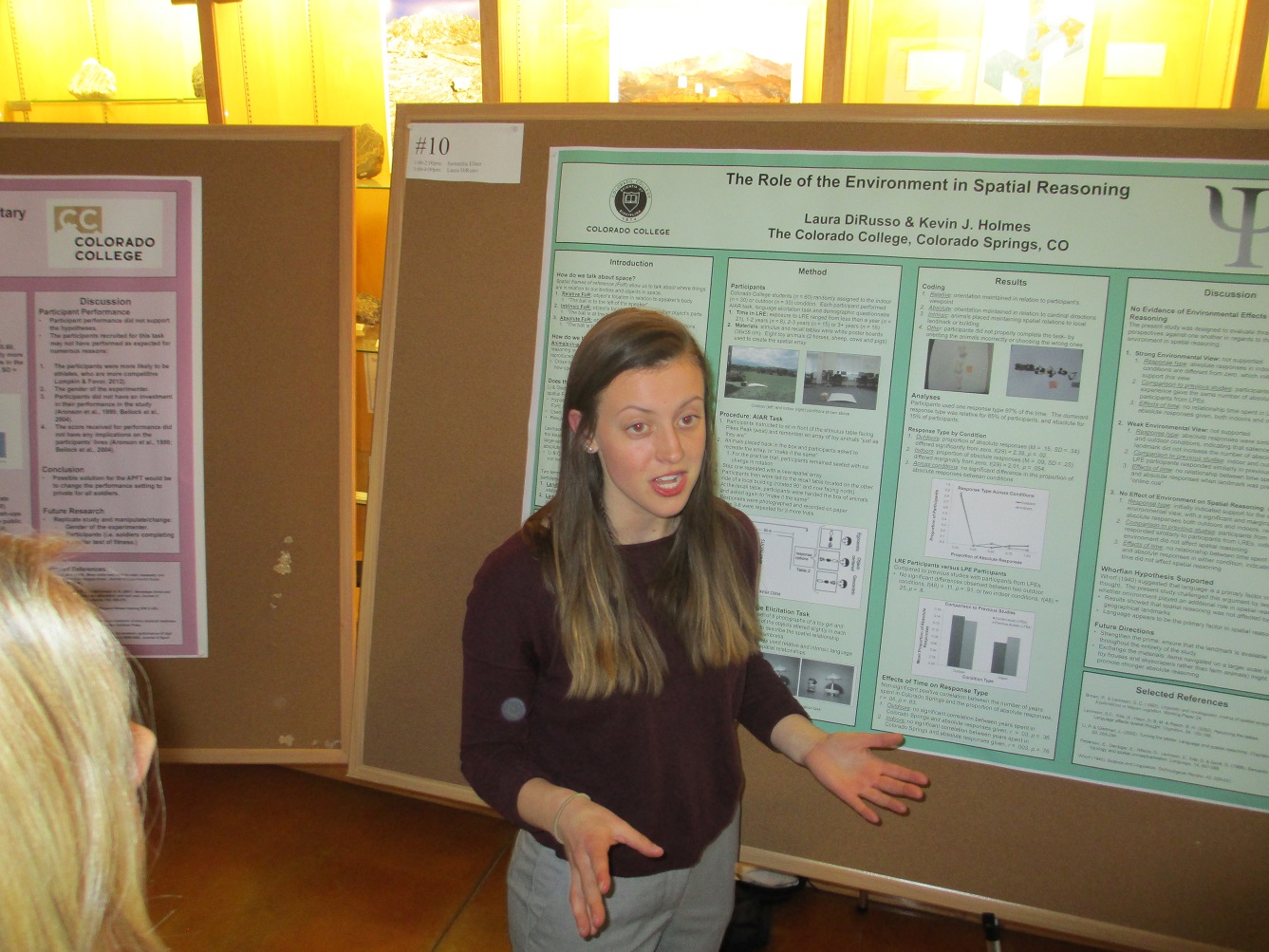
Psychology
Advisor: Kevin Holmes
The Role of the Environment in Spatial Reasoning
Speakers of different languages differ in how they talk about space, and research on nonlinguistic spatial reasoning suggests that they also think about space differently. For instance, English speakers use relative terms (e.g., "left" and "right") to describe spatial relations and Tzeltal speakers use absolute terms (e.g., "north" and "south"), and the two language groups rely on relative and absolute frames of reference (FoRs), respectively, when performing spatial reasoning tasks. These findings have been interpreted as evidence that spatial reasoning depends on language. Alternatively, spatial reasoning may depend more strongly on the surrounding environment than on language. This possibility was investigated by testing spatial reasoning in English speakers residing in a landmark-rich environment. Participants were instructed to memorize an array of toy animals and reconstruct it following a 90-degree rotation. According to the strong environmental view, participants should differ from typical English speakers by relying on the absolute rather than the relative FoR when reconstructing the array, regardless of the testing location (i.e., indoors or outdoors). According to the weak environmental view, participants should rely on the absolute FoR when reconstructing the array, but only when surrounding landmarks are visible (i.e., outdoors). Neither view was supported: the majority of participants relied on the relative FoR, whether tested indoors or outdoors. These results provide no evidence that spatial reasoning is driven by environmental factors, thus supporting the original claim that language is the key factor in spatial reasoning.
Samantha Ellner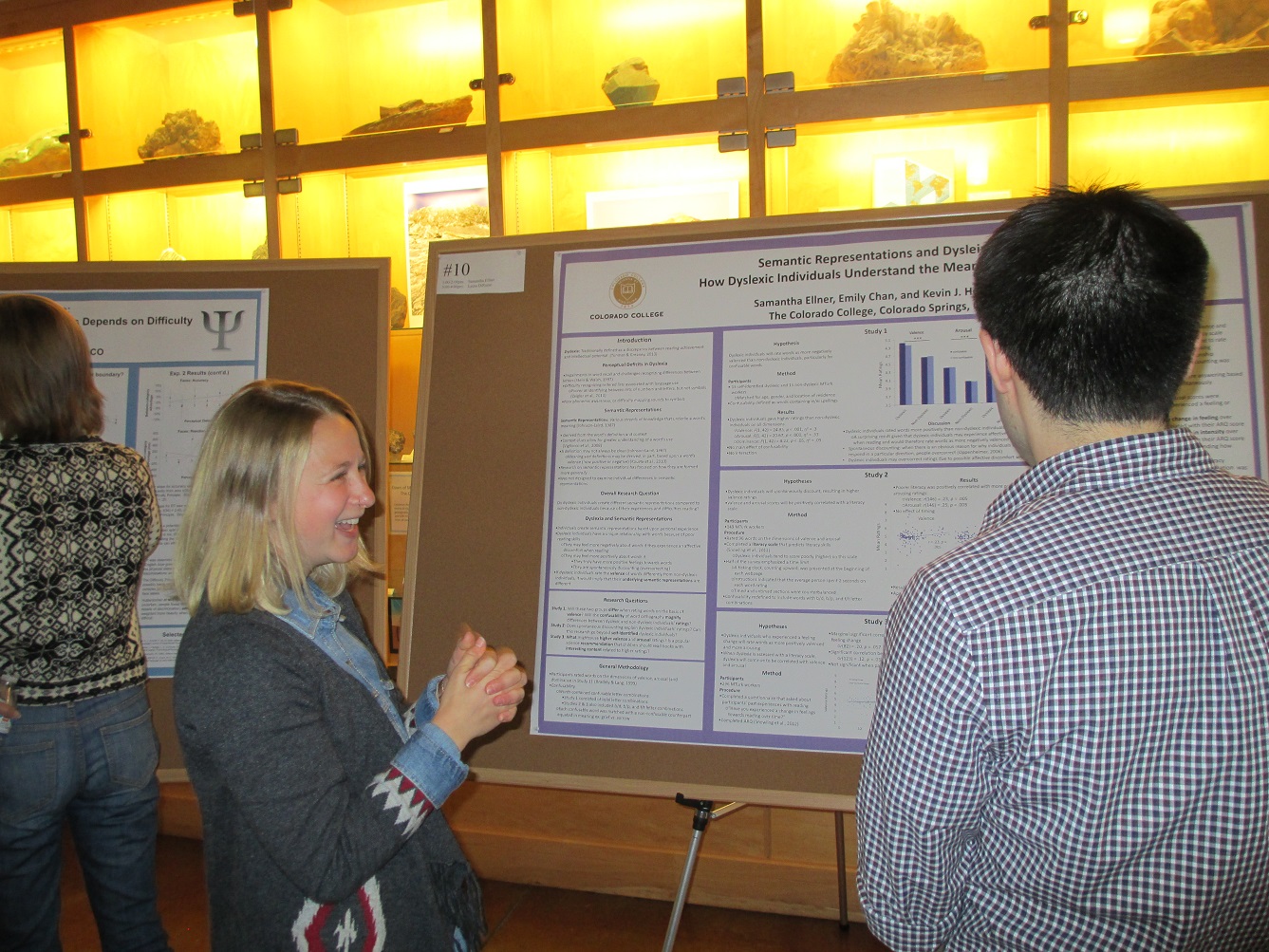
Psychology
Advisors: Kevin Holmes & Emily Chan
Semantic Representations and Dyslexia: How Dyslexic Individuals Understand the Meanings of Words
Reading processing and phonemic awareness are common deficits in dyslexia. This paper reports three experiments designed to investigate the consequences of these deficits for dyslexic individuals' representations of word meaning, as assessed by explicit ratings of word valence. Because of their affective discomfort while reading, dyslexic individuals might be expected to rate words more negatively than non-dyslexic individuals. Alternatively, dyslexic individuals may rate words more positively due to spontaneous discounting, or over correcting, or they may have truly more positive feelings about words. Dyslexic individuals may rate words as having a different valence from non-dyslexic individuals, which may suggest that their underlying semantic representations are different. To test this, three experiments were conducted. Experiment 1 compared self-identified dyslexic participants' word ratings with non-dyslexic individuals' ratings of words on several dimensions. Experiment 2 investigated whether dyslexic individuals' more positive word ratings were due to spontaneous discounting. Experiment 3 included a survey asking participants how their feelings about reading changed over time to address popular-science literature that suggests that providing dyslexic children with interesting reading material may lead the children to feel more positively about reading. It was found that dyslexic individuals rate words as more positively valenced and more arousing in all three experiments. An important limitation of these studies was that the tasks were explicit ratings of words, which may not fully capture an individual's implicit judgments. Future research may include an Implicit Associations Test (IAT) to better capture dyslexic individuals' implicit valence ratings of words.
Alejandra A. Franco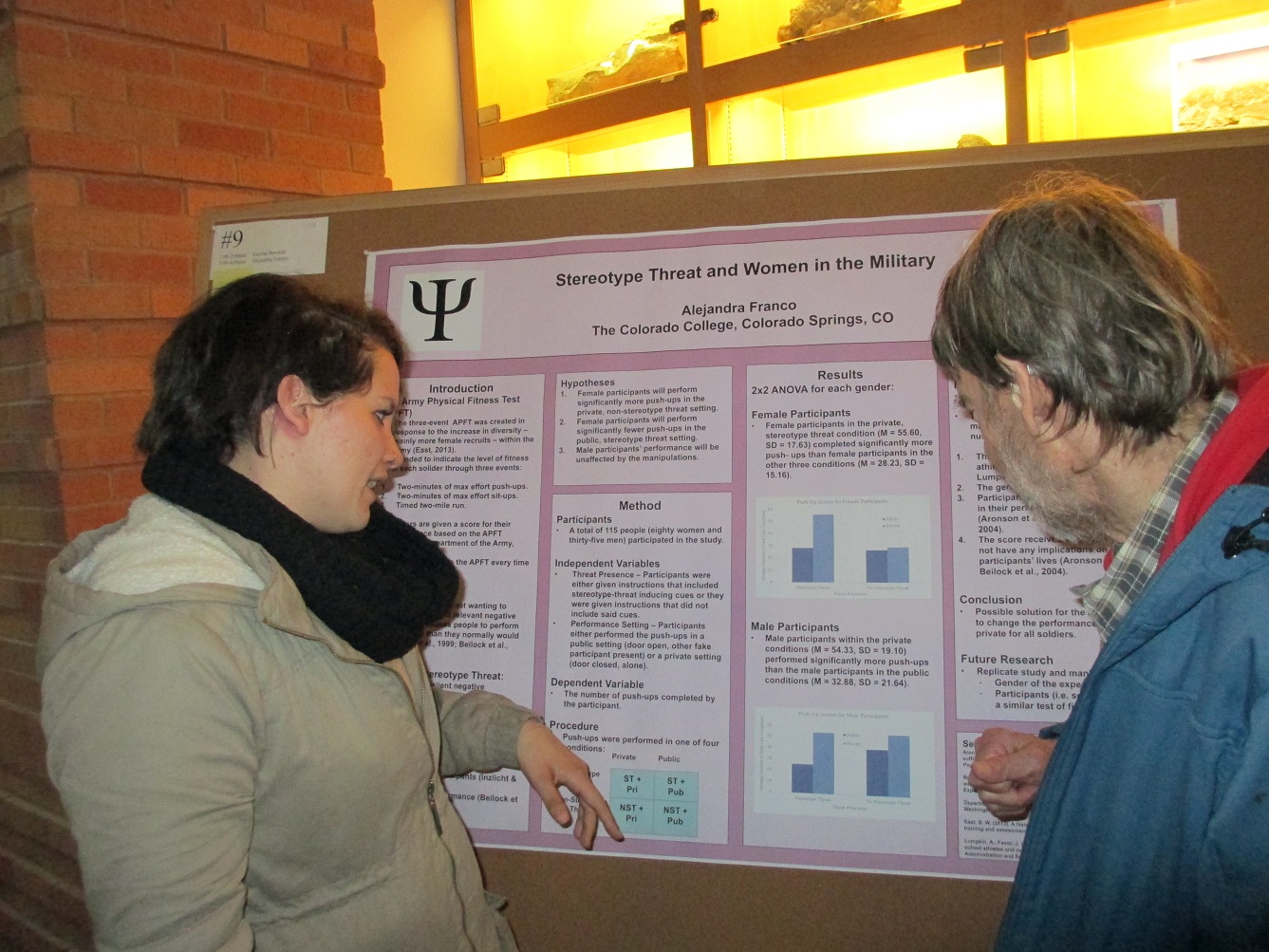
Psychology
Advisor: Jason Weaver
Stereotype Threat and Women in the Military
The current study examined the possibility that the structure of the Army Physical Fitness Test (APFT) may be causing female soldiers to experience stereotype threat. The APFT is a mandatory biannual test of fitness. Every soldier in the United States Army must pass the APFT in order to remain in the Army. Performance on this test is a reflection of soldiers' character and is usually taken into account when determining whether they are worthy of a promotion to a higher rank. Although this study did not demonstrate that stereotype threat appears to be induced through the structure of the APFT, a significant effect contrary to the proposed hypotheses was found: female participants performed significantly more push-ups when given instructions that included various stereotype threat cues within a private setting. The demographics of the participants (athletes of some capacity) and the gender of the push-up grader (female) are discussed as possible explanations for the unexpected effect.
Annalise Grigereit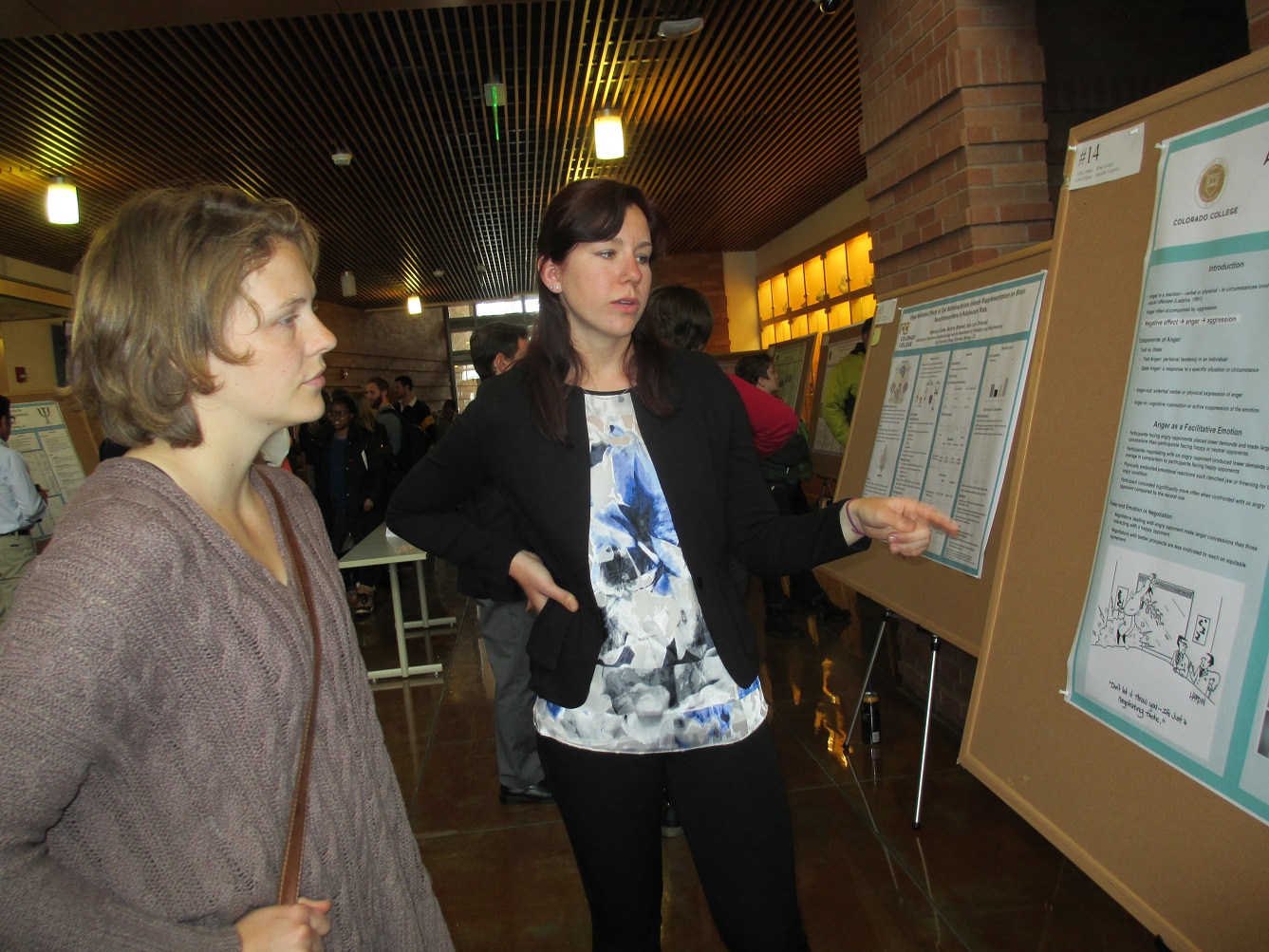
Psychology
Advisor: Tomi-Ann Roberts
Anger Can Be Facilitative, But At What Cost?
Despite its presence throughout human history, the functionality of the emotion we call anger is complex and poorly understood. For the most part, popular belief around anger is that it is a purely destructive emotion. We understand anger as a completely natural component of the human experience and yet, in many situations necessary to maintaining what we consider a quality life - authentic, intimate relationships with other humans - anger is not helpful or facilitative to us. But why should this emotion have evolved if it is so destructive? There are situations in which anger can yield successful outcomes for certain individuals. This review focuses on the situations in which anger is beneficial and when it is not, as well as on which individuals reap the benefits or suffer the consequences of this emotion. In short term negotiations, anger may be beneficial. However, in the long term or in sustained interactions, anger is more often than not destructive to either the individual experiencing it and usually the individual toward whom it is directed as well.
William Harris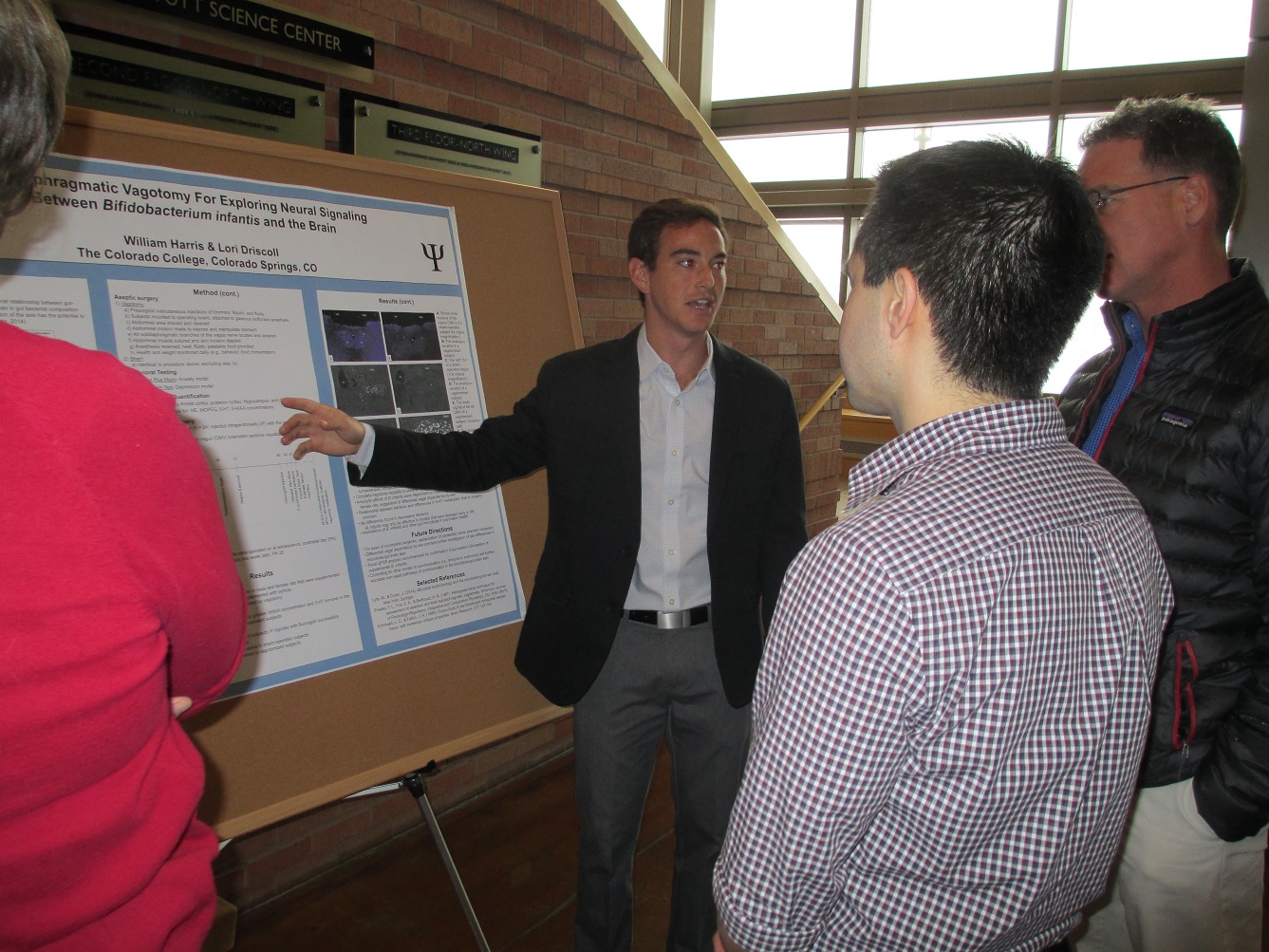
Neuroscience
Advisor: Lori Driscoll
Subdiaphragmatic Vagotomy For Exploring Neural Signaling Between Bifidobacterium infantis and the Brain
The microbiota-gut-brain axis offers a novel avenue for psychopharmacological intervention in health and disease. The trillions of bacteria inhabiting the gut affect the brain via immune, endocrine, and neural pathways, and the exact mechanisms utilized by specific gut microorganisms to modulate neurochemistry and behavior are currently under investigation. In the current study, the probiotic Bifidobacterium infantis (B. infantis), administered to adolescent rats, reduced anxious behavior as measured by the elevated plus maze. Prior to supplementation, the vagus nerve was severed subdiaphragmatically in half of the subjects in order to isolate the unique contribution of neural signaling between B. infantis and the brain. The anxiolytic effect of B. infantis was abolished in male, but not female, rats that had received a vagotomy. These data show for the first time that B. infantis affects anxious behavior in rats with differential vagal dependency by sex. Further research on the various modes of communication between the gut bacteria and the brain will enhance the acuity of the microbiota-gut-brain axis as a model to target behavioral and psychiatric conditions.
Desi Hartman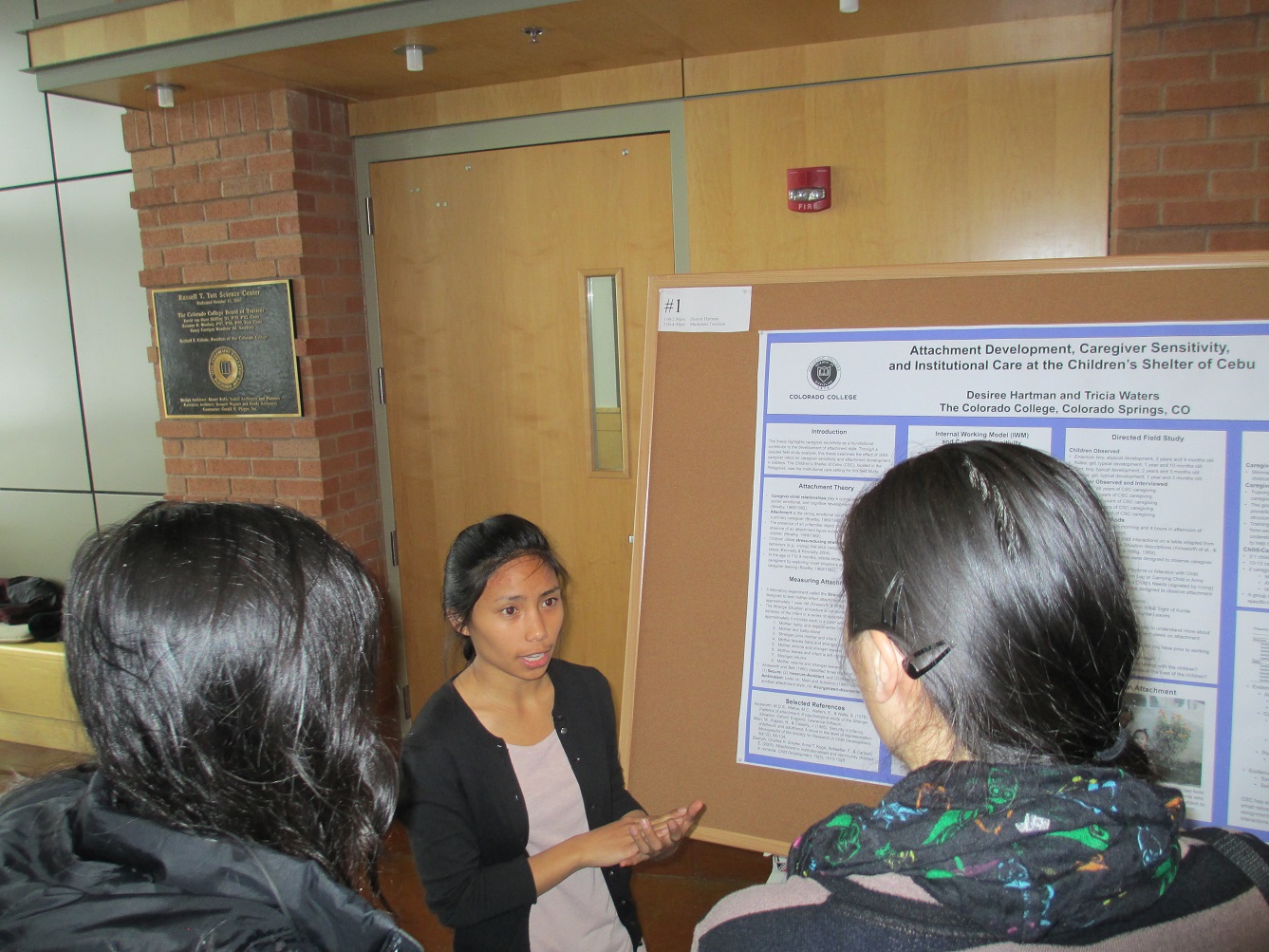
Psychology
Advisor: Tricia Waters
Attachment Development, Caregiver Sensitivity, and Institutional Care at the Children's Shelter of Cebu
According to the World Health Organization (2004), caregiver-child relationships play an imperative role in the growth and development of children around the world. Through the lens of psychology, attachment is the strong, positive emotional relationship that forms between a caregiver and infant (Bowlby, 1969/1982). Unfortunately, for various reasons (e.g. poverty, war, disease, etc.) many parents cannot adequately care for their children and often surrender their children to an institutional care organization where they do not have a primary caregiver, but rather experience early life with multiple caregivers. For more than 50 years, attachment has been widely studied in childcare institutions (Zeanah, Smyke, Koga, & Carlson, 2005). The present thesis highlights caregiver sensitivity as a foundational contributor to the development of attachment style. Through a directed field study analysis, this thesis examined the effect of high child-caregiver ratios on caregiver sensitivity and attachment development in toddlers. The Children's Shelter of Cebu (CSC), located in the Philippines, was the institutional care setting for this field study. Observations suggested that relatively small child-caregiver ratios, regular caregiver schedules, and caregiver attitudes helped CSC create an institutional care environment that supported the development of healthy attachments.
Erica Hoffman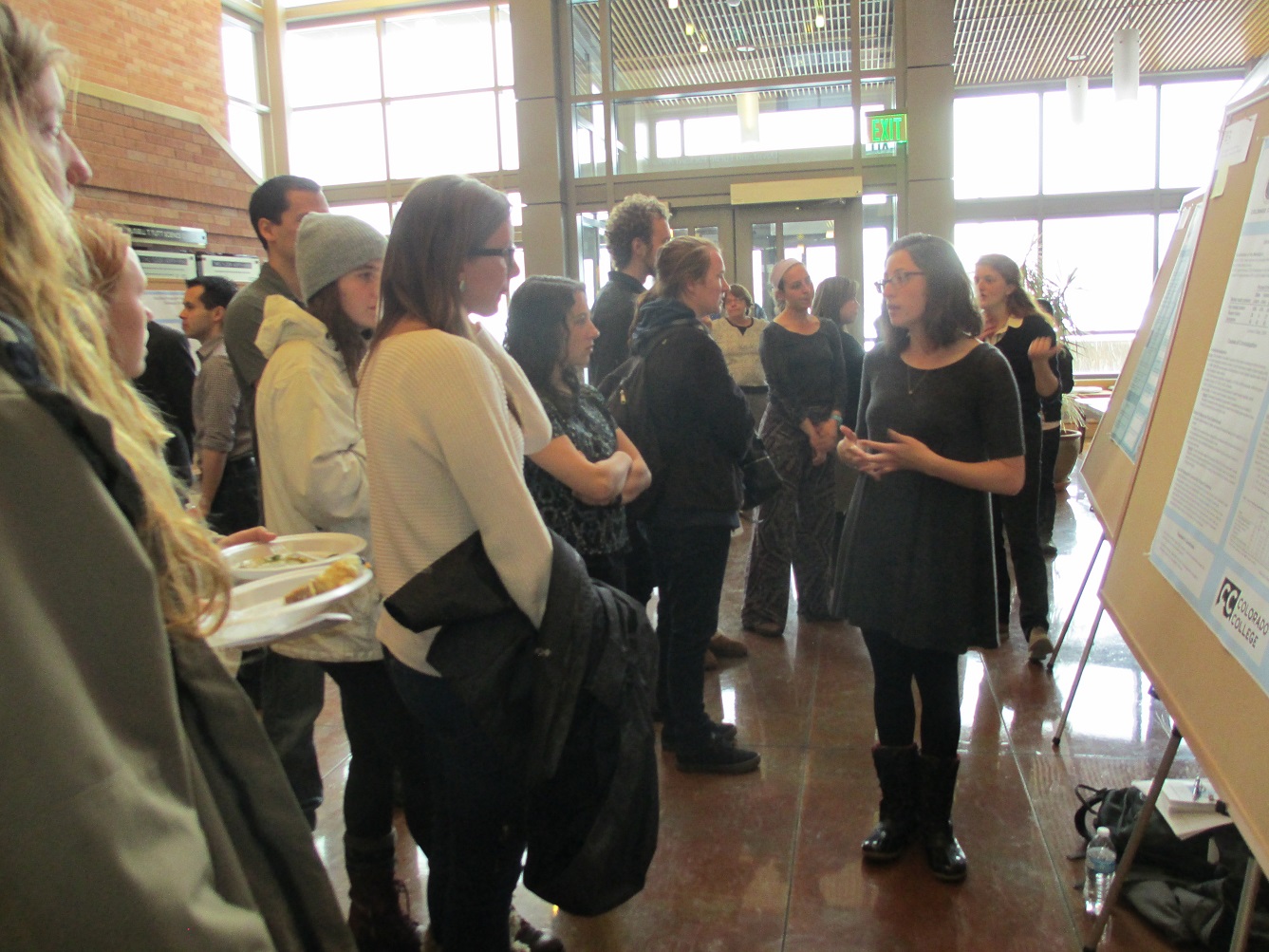
Psychology
Advisor: John Horner
Mental Health Concerns in the U.S. Criminal Justice System
Since the 1970s, there has been an increasing number of individuals with mental illness involved in the U.S. criminal justice system. Such high rates of mental illness among prison populations can be attributed to deinstitutionalization, more stringent criteria for civil commitment, and lack of adequate community support systems. Once inside the prison system, these individuals are not being met with the appropriate treatment services their illnesses require, placing them at a heightened risk to recidivate. Recently, research has begun to address this need for an increase in mental health resources by evaluating different treatment services, like jail diversion programs and mental health courts. A review of the literature indicates that there must be a reorientation of response by both the criminal justice and mental health systems in order to divert the mentally ill from the prison system and into the community.
Adam Hunter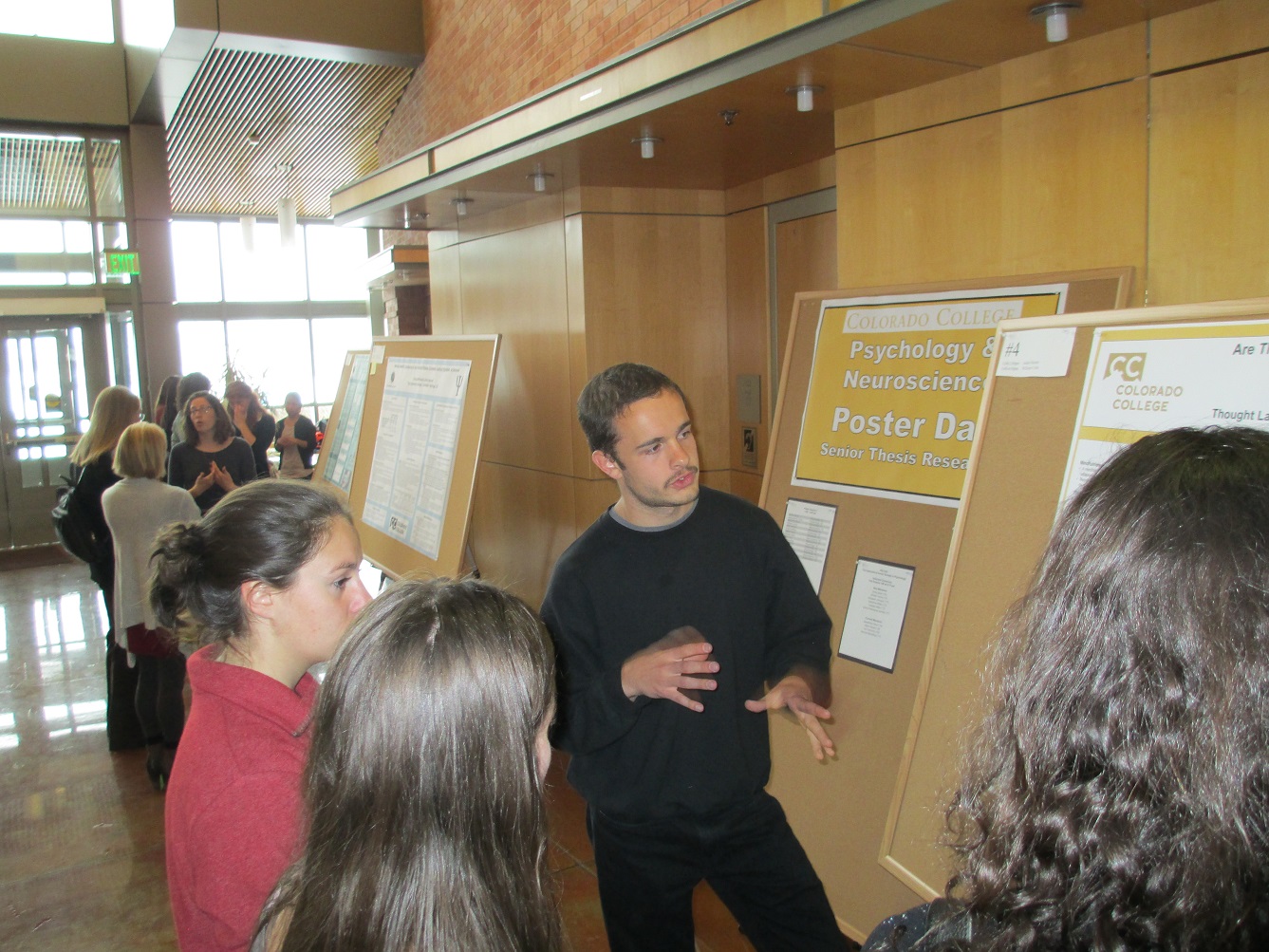
Psychology
Advisor: Kevin Holmes
Are There Two Distinct Cognitive Components in Mindfulness Meditation?
Mindfulness meditation is a form of meditation that is clinically prescribed to treat a variety of mental and psychosomatic problems. Mindfulness has been described as involving two distinct components which are referred to as relabeling and refocusing in this paper. Refocusing is defined as the practice of shifting attention to a relatively stable locus, like the sensations associated with breathing, while relabeling is defined as changing the way percepts are perceived in a way that reflects their inherently transient nature. Despite the distinction made between the components, no research to date has compared the two in their effects. The current research was such a comparison. The effects of four types of meditation, including two techniques which mimicked the two mindfulness components, were compared. Participants meditated for 15 minutes, and the effect of that meditation session on stress levels and responsiveness to appetitive stimuli was assessed. All groups performed equally on tests of responsiveness to appetitive stimuli, and overall stress levels were also similar. It was found that baseline stress levels were more strongly correlated with stress reduction for the mindfulness components than for the other meditation techniques. These findings suggest that the two components of mindfulness are similar in their effects, supporting the implicit assumption of many contemporary mindfulness researchers that the components do not need to be separated.
Kiersten Kelly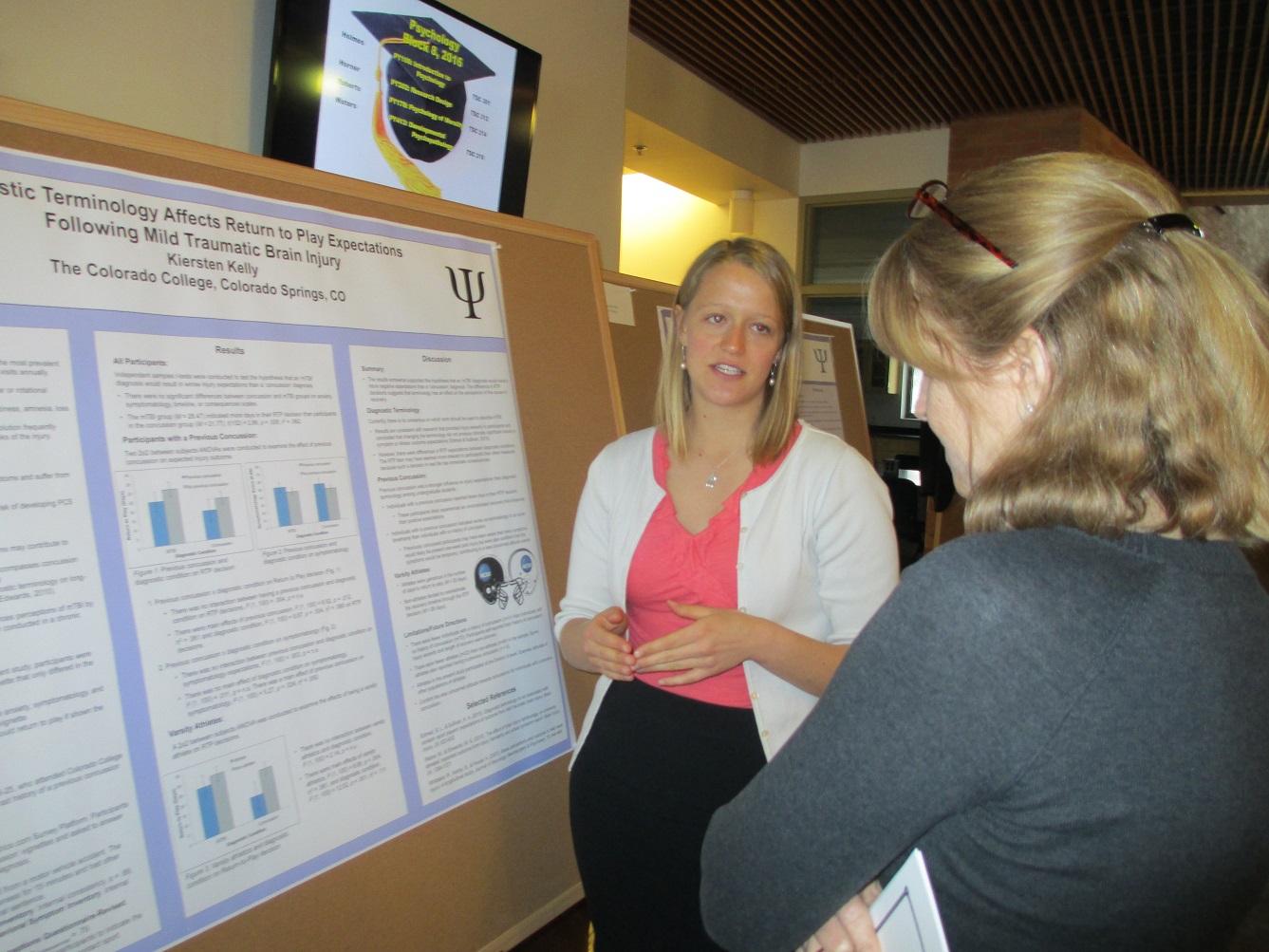
Neuroscience
Advisor: Kristi Erdal
Diagnostic Terminology Affects Return to Play Expectations Following Mild Traumatic Brain Injury
'Mild traumatic brain injury' (mTBI) and 'concussion' are terms used interchangeably. However, 'mTBI' is frequently seen as representing a broader injury concept that encompasses the construct of 'concussion,' which often conveys transience or decreased severity. The present study examined the influence of varying diagnostic terminology on injury expectations in an undergraduate population (N=105). Participants were presented with an mTBI vignette and were randomly allocated to one of two conditions in which the term 'mTBI' or 'concussion' was used to describe the injury. There were no significant differences between the two conditions on anxiety, symptomatology, timeline, or consequence scales. However, participants in the 'mTBI' group allocated more days to return to play than participants in the 'concussion' group, suggesting that terminology has an effect on perceptions of the severity of the injury. Individuals with a history of concussion indicated less projected anxiety, fewer days to return to play, but greater symptomatology than individuals with no history of concussion. Varsity athletes also allocated fewer days to return to play than non-athletes. Clinicians should consider the influence of diagnostic terminology, previous history of concussion, and athletic background on perceptions of the severity of an injury because expectations can influence injury outcomes and compliance in a recovery process.
Melissa Lacer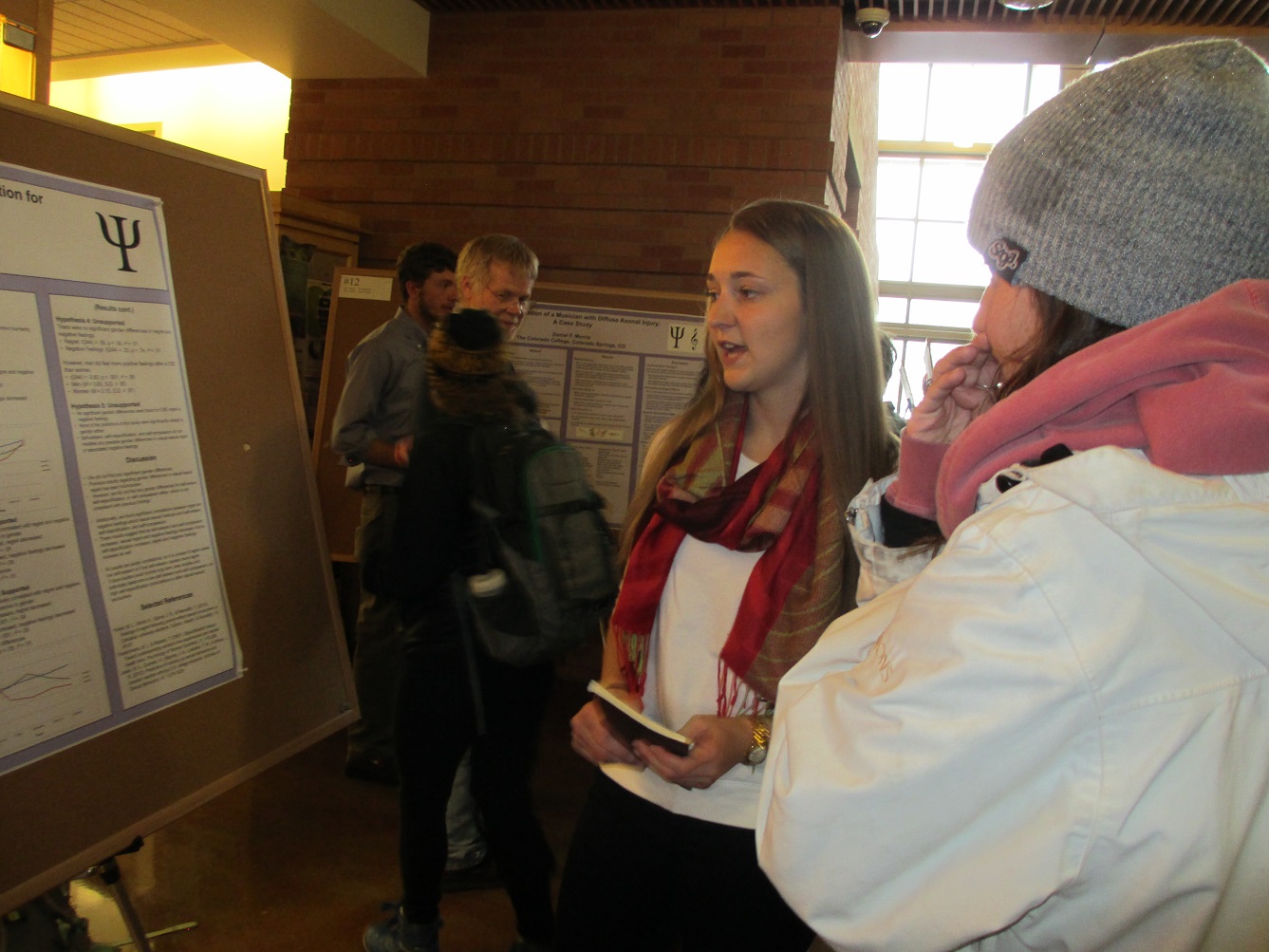
Psychology
Advisor: Tomi-Ann Roberts
Predictors of Regret and Related Negative Emotion for Males and Females After Casual Sex
This study sought to investigate the effects of gender on casual sexual regret and associated negative feelings. We investigated self-esteem, self-compassion, and self-objectification as possible mediators between gender differences in regret and negative feelings. The survey included attitudes about noncommittal sexual encounters, or hookups, and most recent history of hookups and the effects thereof. We assessed a list of positive and negative feelings and found significant correlations between gender and positive feelings regarding a hookup, where males feel more positive than females after a casual sexual encounter, but not between gender and negative feelings. We did not find any results regarding gender differences for self-esteem, self-compassion, and self-objectification. However, we found that participants with lower self-esteem and self-compassion feel more negative about hookups than those with high self-esteem and self-compassion. We also found a negative correlation between self-objectification and positive feelings. Previous research is inconsistent about gender differences in regrettable sex, however perhaps more attention should be focused on the underlying reasons for the regret and negative feelings, instead of possible gender differences. Further research should investigate other possible mediators of gender on feelings regarding casual sexual encounters beyond self-esteem, self-compassion, and self-objectification.
Ryan Lach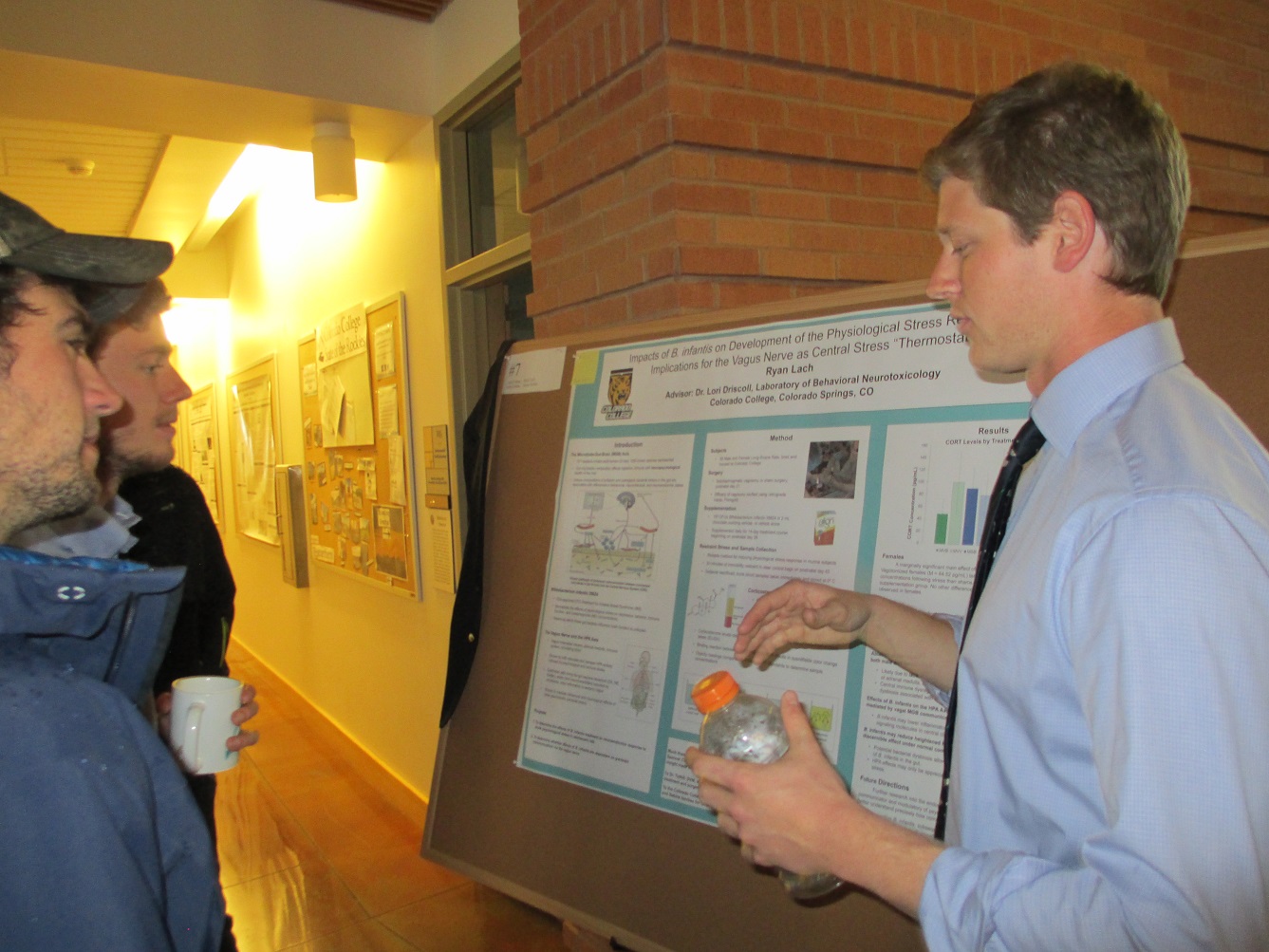
Neuroscience
Advisor: Lori Driscoll
Impacts of B. infantis on Development of the Physiological Stress Response: Implications for the Vagus Nerve as Central Stress "Thermostat"
The hypothalamic-pituitary-adrenal (HPA) axis-the system that enacts the physiological stress response in mammals-is functionally affected by differences in the speciation and cellular activity of commensal microbiota that inhabit the gastrointestinal (GI) tract. Chronic and acute dysregulation of HPA activity often accompany psychiatric conditions, and the mechanisms involved in gut microbiota-neuroendocrine interaction, as well as and how it contributes to neuropsychological health and disease, is not well understood. In the present study, the effect of extended supplementation with the probiotic strain Bifidobacterium infantis 35624 on the acute HPA responsivity of vagotomized and sham-operated adolescent rats was examined. No significant differences in serum corticosterone (CORT) levels were observed in subjects based on the factors of supplementation type, surgery type, or sex. Despite this, vagotomized animals tended to have higher blood CORT concentrations following restraint stress than sham counterparts, a phenomenon that was "rescued" in male subjects supplemented with B. infantis. These findings suggest that B. infantis does not exert appreciable dampening effects on the HPA axis via neural signaling of the vagus, but rather affects independent biochemical and cellular pathways via humoral routes. Results also affirm that B. infantis may only significantly affect the HPA axis under dysbiotic conditions, such as would be present in disorders of the GI tract. Further study of the precise conditions and physiological systems involved in B. infantis-HPA interaction is required before the strain can be properly characterized as neuropsychologically beneficial.
Ryan Looney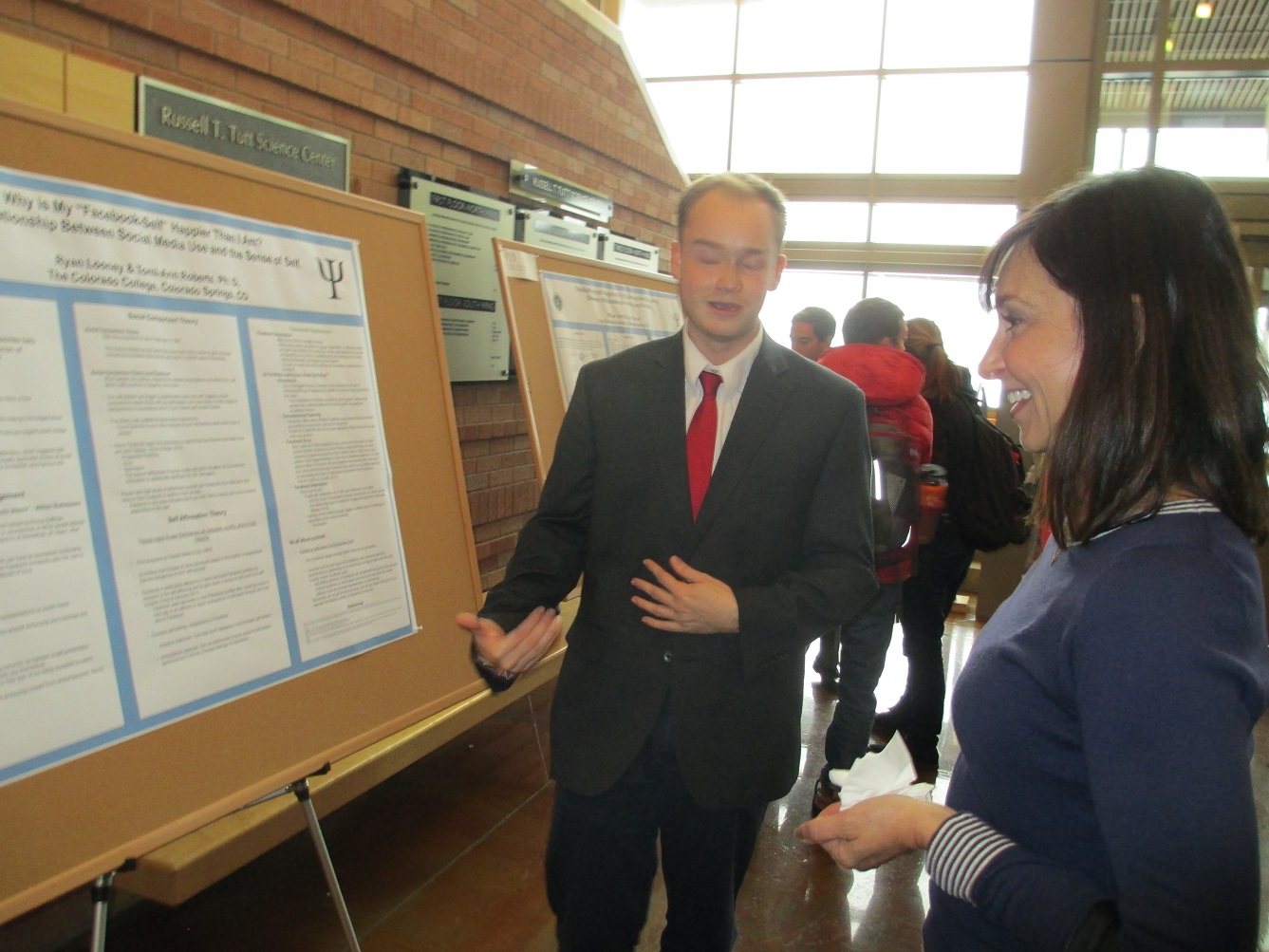
Psychology
Advisor: Tomi-Ann Roberts
Why is my "Facebook-self" Happier than I am? The Relationship Between Social Media Use and the Sense of Self
How participation in social media impacts one's sense of self is a complicated question. The research on the relationship between self-esteem and social media use has some agreement, but also areas of contradiction. The concept of Facebook depression has gotten a lot of attention recently and notable research has been done. In order to understand Facebook depression and the relationship of social media to self-esteem it is necessary to review the research in the areas of social comparison theory, impression management theory, and self-affirmation theory. Facebook profiles can be thought of as a second version of one's self, which users constantly manage. The psychological implications of self-editing online over a period of time has just started to be examined. It appears there is some correlation between Facebook usage and signs of mental health problems. However, there is disagreement on whether or not Facebook usage causes these problems or if a predisposition to having mental health challenges leads people to social networks.
Julian McGinn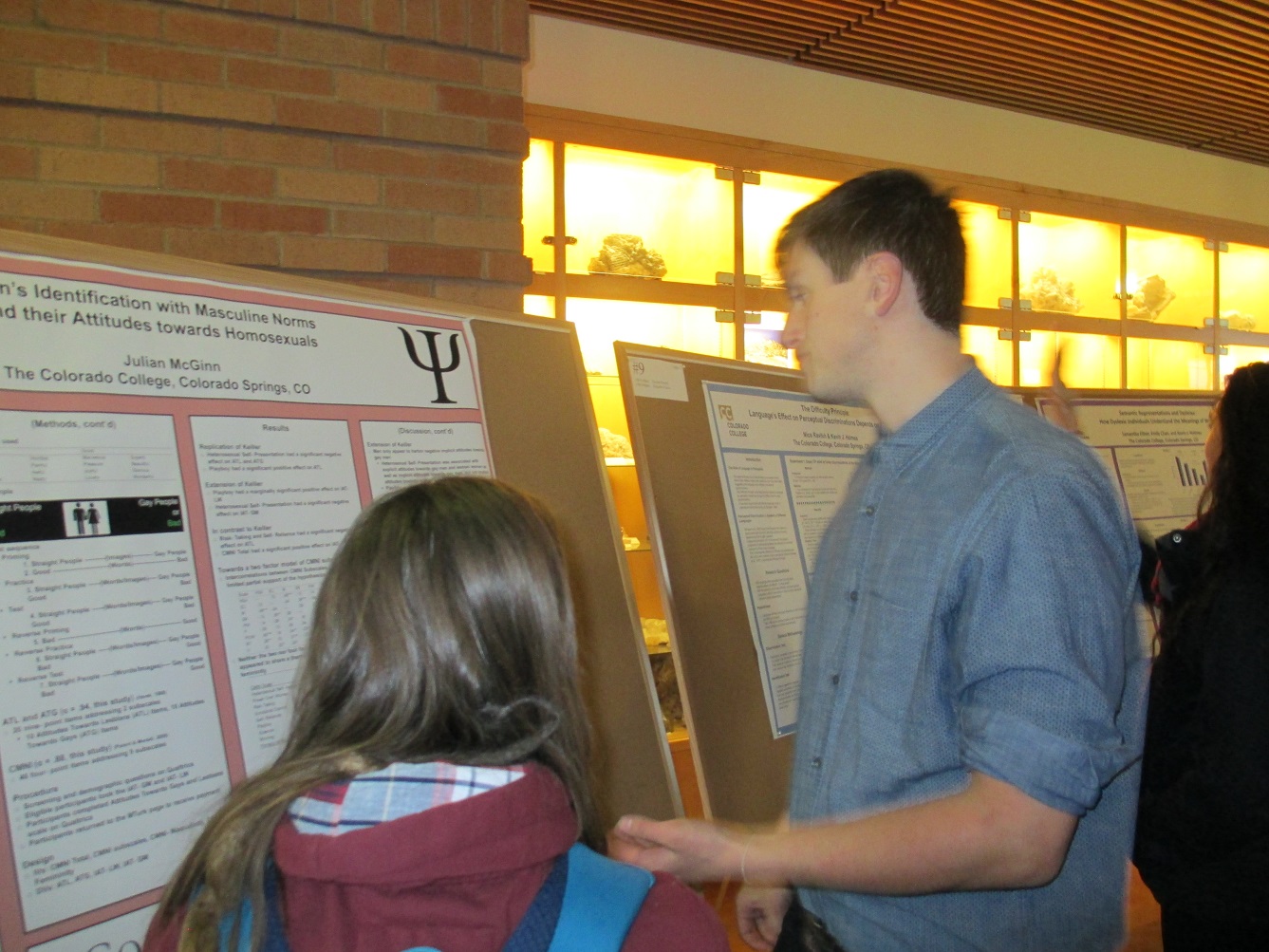
Psychology
Advisor: Jason Weaver
Men's Identification with Masculine Norms and their Attitudes towards Homosexuals
The purpose of this study was to determine if masculine norms predicted attitudes towards gay men and if masculine norms, attitudes towards bisexual women, and beliefs about the fluidity of women's sexuality predicted attitudes towards lesbian women. Eighty-three straight cisgender men between the ages of 18 and 35 who had lived in the United States their whole life were crowdsourced from Amazon Mechanical Turk. These men took the Implicit Association Test- Gay Men (IAT- GM), the Implicit Association Test- Lesbian Women (IAT- LW), the Conformity to Masculine Norms Inventory (CMNI), the Sexual Orientation Beliefs Scale (SOBS), the Gender Specific Binegativity Scale (GSBS), and the Attitudes Towards Lesbians and Gay Men Scale (ATLG- R). Men were found to hold only negative explicit and implicit attitudes towards gay men, and both positive and negative explicit and implicit attitudes towards lesbian women. The SOBS, the GSBS, and reorganization of the CMNI did not provide further explanation of attitudes. Results suggested that either pornographic consumption or application of balance theory could explain positive attitudes towards lesbian women. The functional approach to attitudes theory and methodological differences between studies are possible reasons why no negative implicit attitudes towards lesbian women were found. Suggestions for future studies include examining the relationship between pornographic consumption and identification with masculine norms, examining the effect of functional attitudes held by men on explicit and implicit attitudes towards homosexuals, or the direct application of balance theory to men's attitudes towards lesbian women.
Daniel F. Morris
Psychology
Advisor: Kristi Erdal
Neurorehabilitation of a Musician with Diffuse Axonal Injury: A Case Study
This case study explores neurorehabilitation of a musician through one year post-injury after a high speed car accident. Mr. C., a professional musician, was diagnosed with diffuse axonal injury (DAI) and was in a coma for 26 days. Following his hospital stay, Mr. C. was admitted to a rehabilitation hospital where he remained until day 90 post-injury. Medical records were obtained and interviews were conducted with Mr. C. and his fiancée, A. E., just after the one year anniversary of the accident. Results revealed minor cognitive deficits in memory, word finding, speech production, attention, and changes in personality (disinhibition). These minor deficits are largely unnoticeable and have had virtually no impact on his professional life. The potential beneficial effects of musical training, the effects of neuropharmacological medications, and the benefits of social support are explored. In corroboration with existing research, Mr. C.'s largely successful recovery demonstrates the potential for further research in the neuroplastic changes involved in the rehabilitation process following DAI and in such practices as Neurologic Music Therapy (NMT) or Music-Supported Therapy (MST).
Michael Murney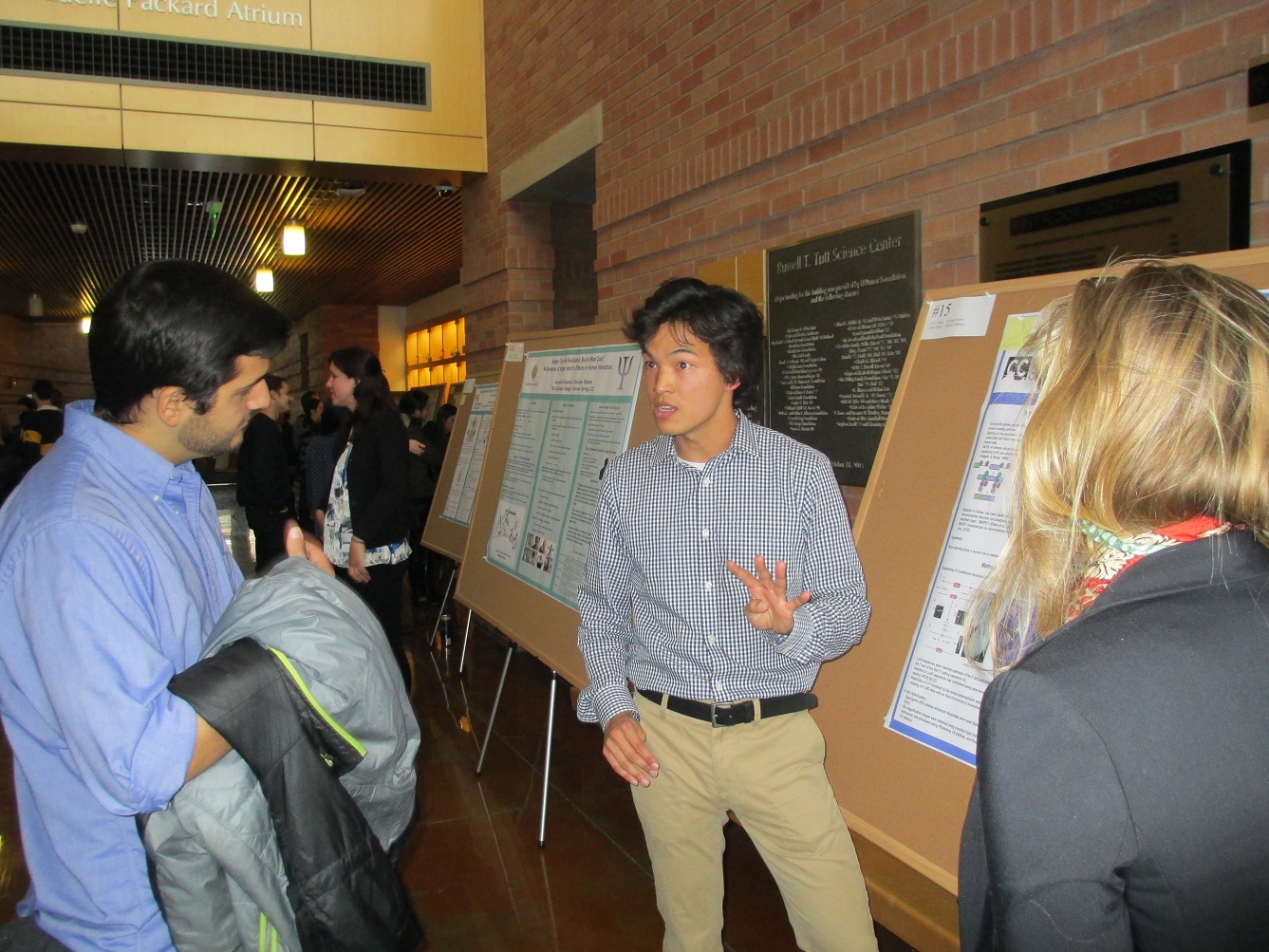
Psychology
Advisor: John Horner
Loss of U11 snRNA Causes Cell Cycle Defect and Microcephaly in Mice
As most eukaryotic genes are segmented into protein-coding exons and non-protein coding introns, eukaryotic gene expression depends upon excision of introns and ligation of exons from pre-mRNA molecules to form functional mRNA transcripts. This process of intron excision and exon ligation is known as splicing, and is mediated by one of two distinct cellular complexes in most plants and animals. More than 99.5% of all introns in plants and animals are processed by the first of these complexes, which is accordingly named the major spliceosome. The remaining 0.5% of introns are excised by the second complex, called the minor spliceosome. In humans, mutations in Rnu4atac, a gene coding for an essential component of the minor spliceosome, has been linked to the developmental disorder microcephalic osteodysplastic primordial dwarfism type 1 (MOPD1). In addition to marked defects in limb and skeletal development, MOPD1 patients exhibit extreme reduction in cerebral cortex volume (microcephaly), indicating that minor splicing plays an especially crucial role in mammalian cortical development. In order to assess exactly how minor splicing dysfunction causes impairment of cortical development, a conditional knockout mouseline in which minor spliceosome disruption is restricted to the developing cortex was developed. Results of this study suggest that loss of minor splicing causes cell cycle impairments in cortical progenitor cells that specifically impact processes of neurogenesis and neuronal migration.
Nico Ravitch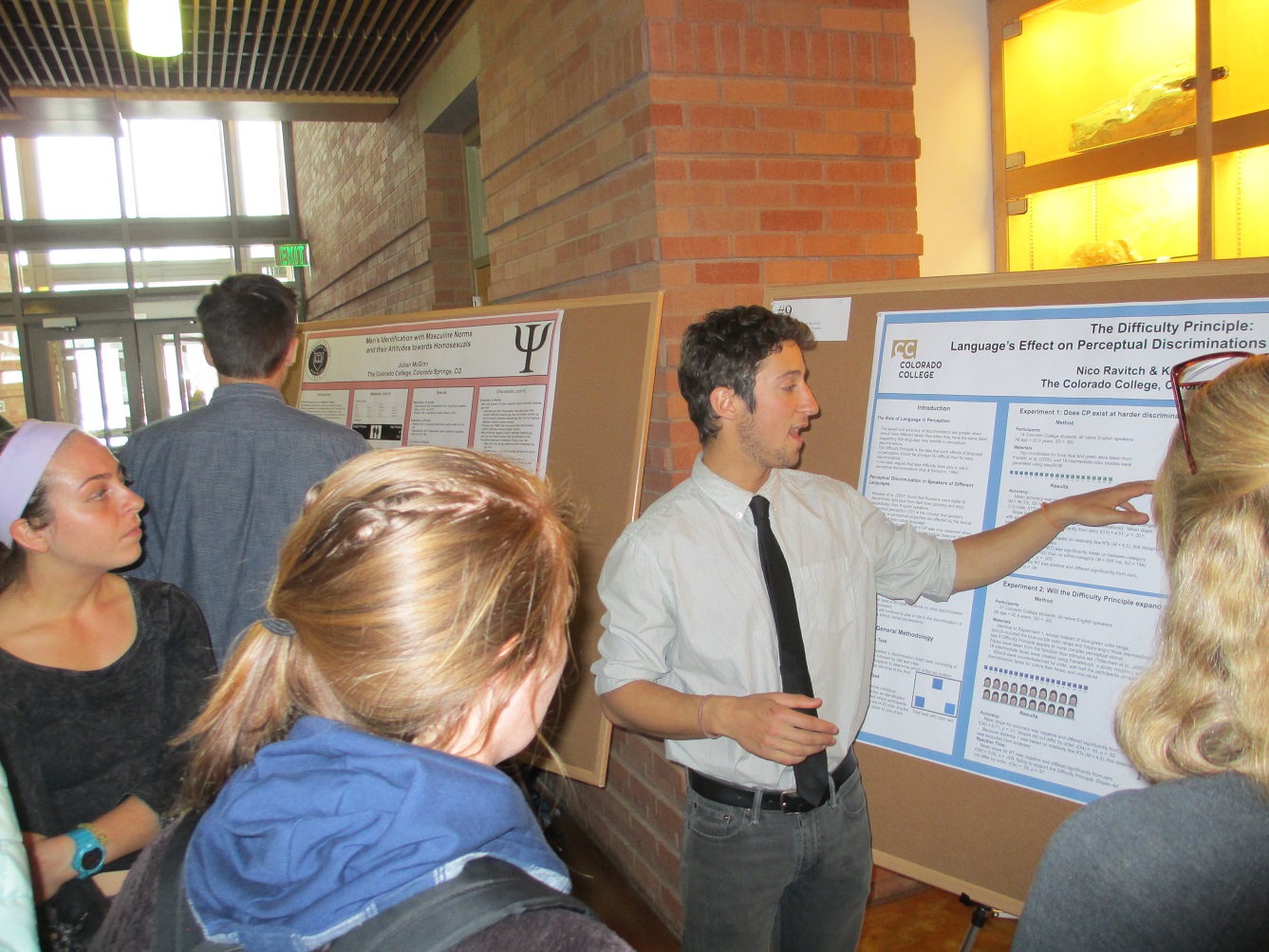
Psychology
Advisor: Kevin Holmes
The Difficulty Principle: Language's Effect on Perceptual Discriminations Depends on Difficulty
Previous research suggests that when people discriminate visual stimuli such as colors and objects, they unconsciously access the labels of those stimuli. These labels subsequently affect discrimination, with superior performance when stimuli have different labels than when they have the same label. It has been argued that such effects should be stronger for difficult than for easy discriminations (i.e., when colors are physically more similar), and some preliminary evidence exists for this possibility-a phenomenon described here as the Difficulty Principle. The current study provided a broader test of the Difficulty Principle. In Experiment 1, participants discriminated colors at the green-blue boundary. The results showed superior performance for between-category discriminations than within-category ones, but critically, this effect was stronger when the discriminations were more difficult. Experiment 2 tested whether the Difficulty Principle would generalize to another color boundary (blue-purple) and to more complex stimuli (facial expressions), providing support for the former but not the latter. Taken together, the findings indicate that the Difficulty Principle underlies the perceptual processing of color, but may not carry over to more complex perceptual domains.
Juwan Rohan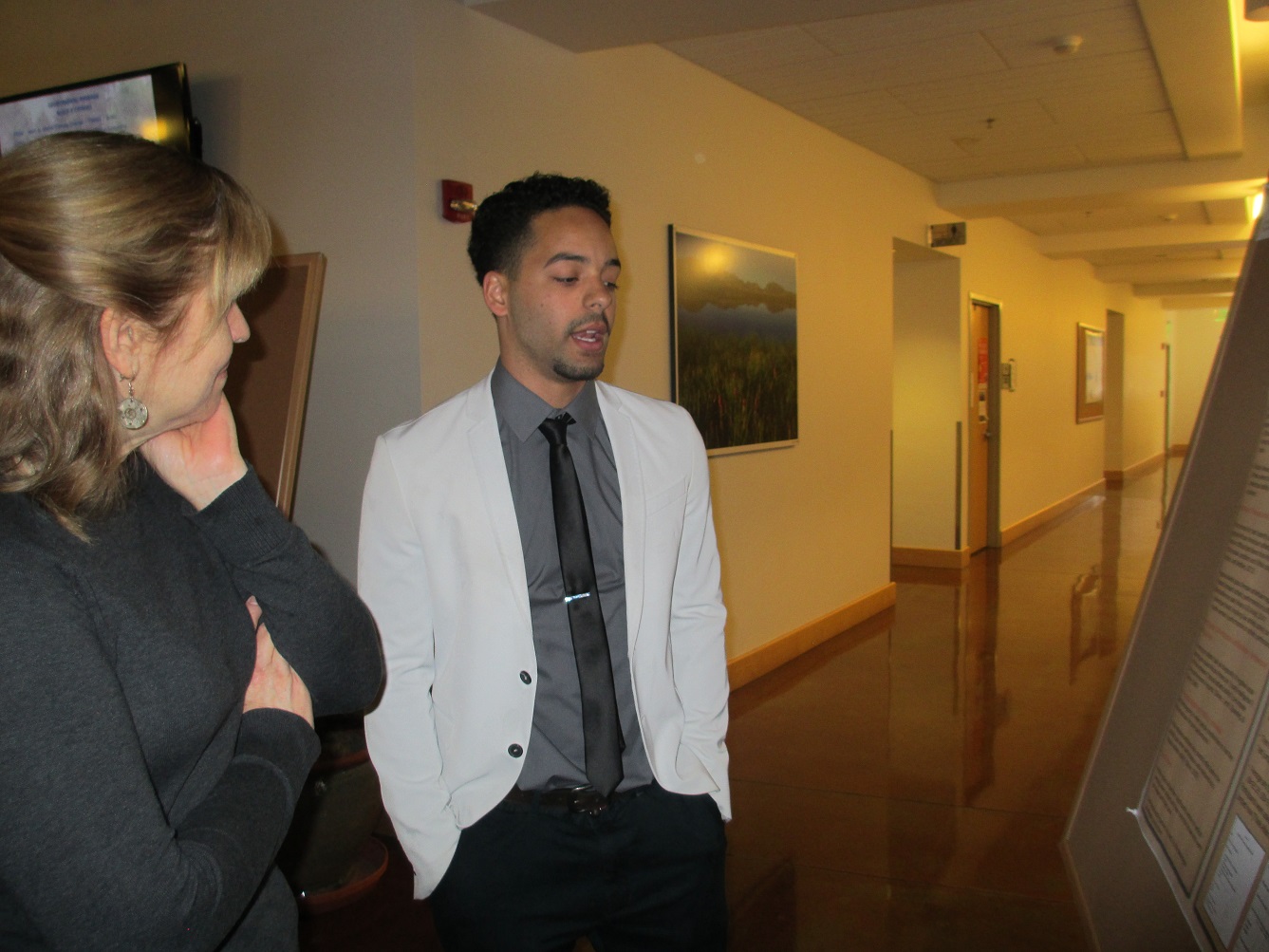
Psychology
Advisor: Kristi Erdal
White Men Can't Jump or Can They? A Lack of Stereotype Threat on White Athletes' Vertical Jumping
Stereotype threat refers to a situation in which individuals feel at risk of conforming to negative stereotypes about their social group. In the current study, race and athletics were examined on White athlete's jumping ability based on the notion "White Men Can't Jump." The hypothesis is that White males will perform significantly worse on vertical jumping when primed with their race than those who were not primed with their race. The second hypothesis is that self-handicapping would be used by the stereotype threatened group more. In contrast to the hypotheses, priming White athletes with their race before a vertical jump test did not affect their jumping height. Participants were not affected by the stereotype that "white men can't jump." Future studies should explore a stronger race prime because perhaps the race prime was not apparent. Future directions should prime the task instead of participant's race and make it more evident to the participants.
Karen Rojas-Palacios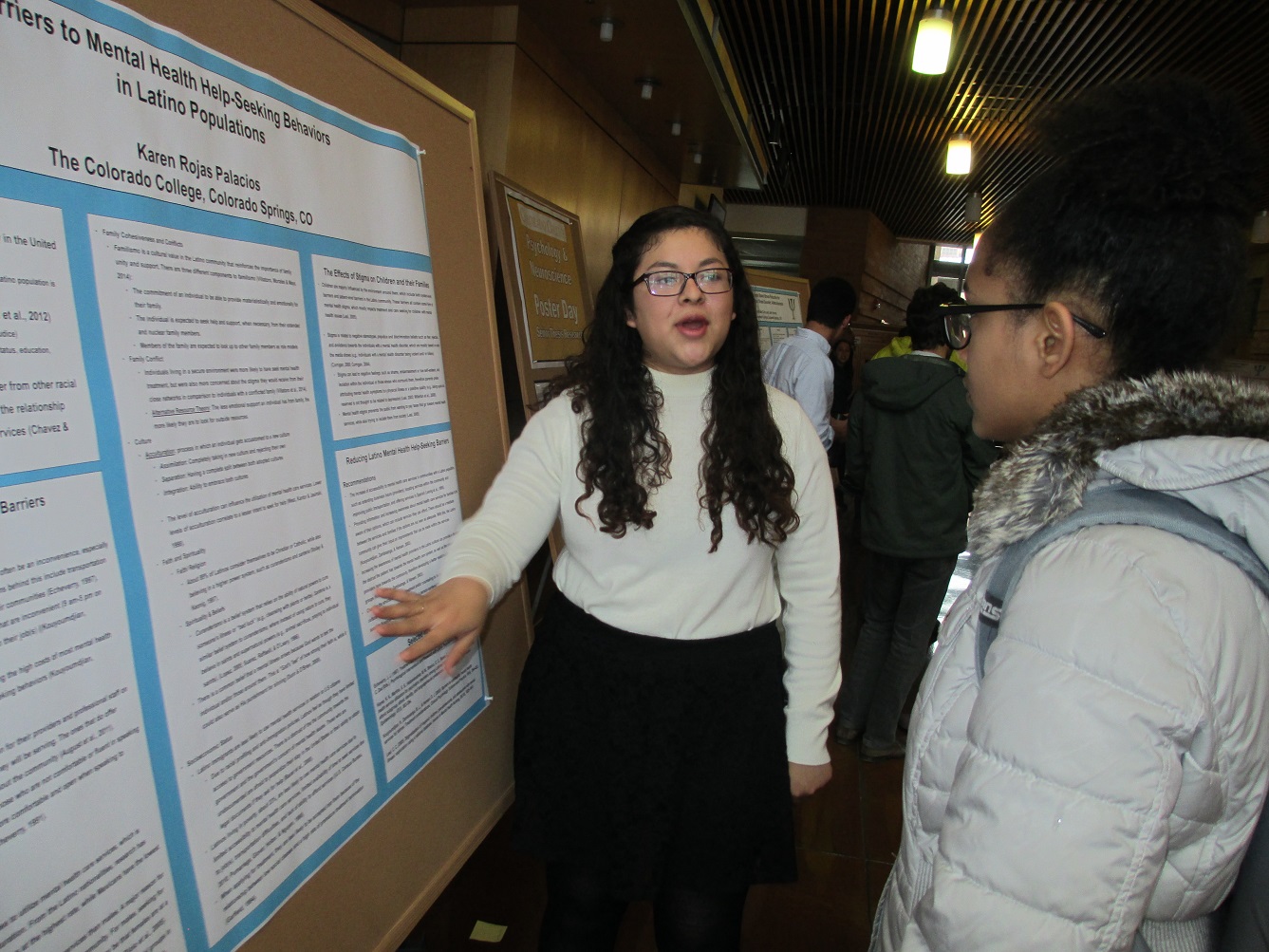
Psychology
Advisor: Emily Chan
Barriers to Mental Health Help-Seeking Behaviors in Latino Populations
Ethnic minorities in the United States are more likely to develop a mental illness in comparison to Whites, while also having a higher level of stigma in their communities towards mental health and help-seeking. Latinos, as the largest growing racial minority, should be able to access and know about the medical services that are available to them, but there are multiple personal and social barriers that create a stigma around seeking for mental health care. Thus, it is important to understand the role culture plays not only in the development of mental health stigma and its effect on help-seeking behaviors in ethnic and racial minorities, but also the prevalence and causes of mental illnesses in these communities. Communities that are composed of majorly a Latino population should look into training professionals to reach out to the community and their patients in order to establish a positive relationship between the system and the individual. Not only will this help out more people who need the treatment, but it will also allow breaking of some of the stigma and perceived barriers around mental health.
Alison V. Rowe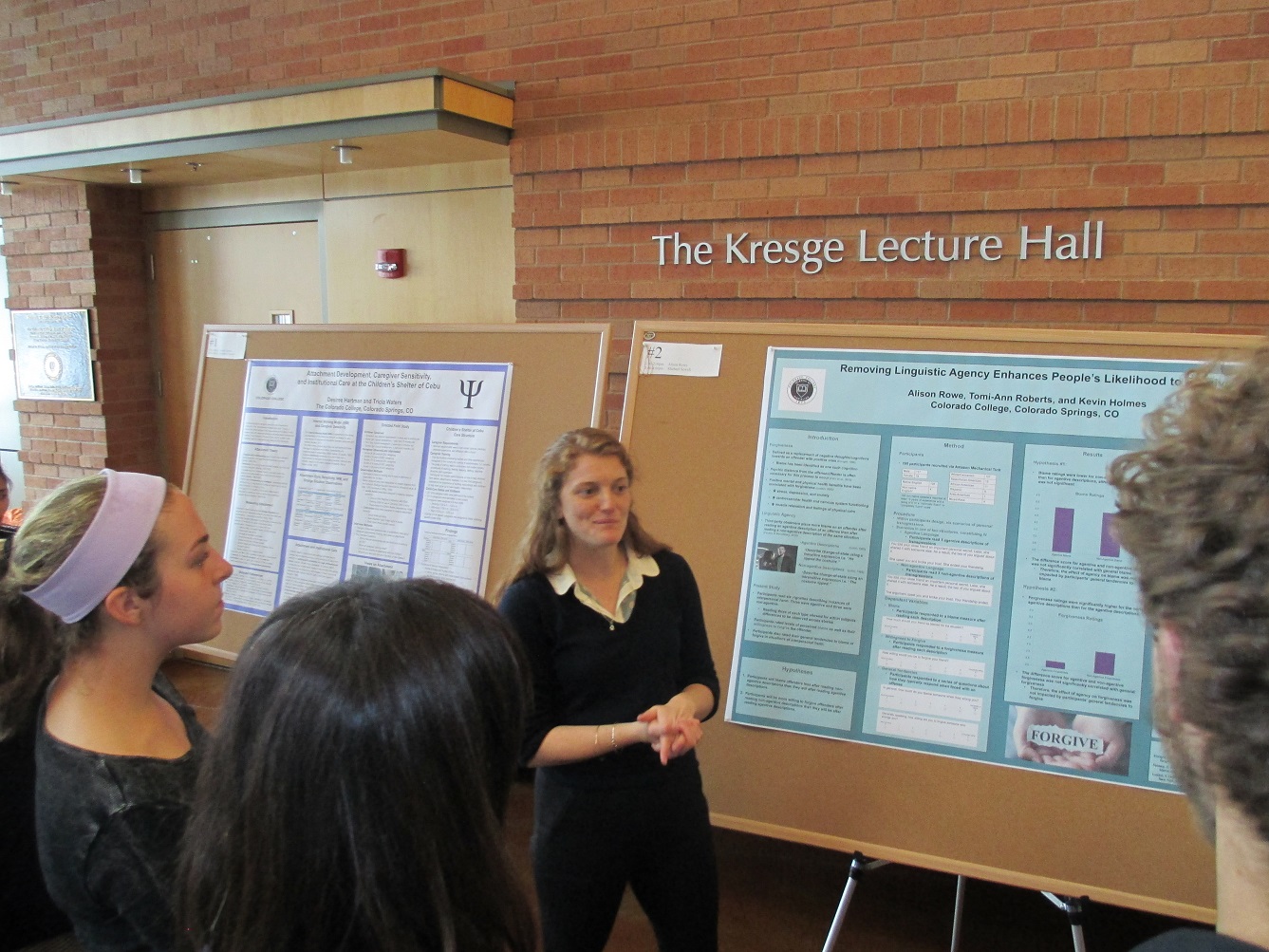
Psychology
Advisor: Tomi-Ann Roberts
Removing Linguistic Agency Enhances People's Willingness to Forgive
Forgiveness has been connected with a series of positive mental and physical health benefits, yet individuals still find themselves struggling to achieve it. This may be due to an inability to distance themselves from the situation. Cognitive research has demonstrated that agentive language is the default structure for English speakers, and that a removal of linguistic agency, reduces levels of perceived blame of an offender. The present study thus suggests this switch to a non-agentive language as a method for achieving a greater willingness to forgive. Two hundred MTurk workers were asked to read a series of vignettes depicting instances of personal harm, and then rate levels of perceived blame of the offender and willingness to forgive. Forgiveness ratings were significantly greater in response to non-agentive stories than agentive stories. This demonstrates that participants were more willing to forgive when prompted with a non-agentive story than with an agentive one. Additionally, this is not impacted by participants' general tendencies to forgive or blame. Although no significant difference between ratings of perceived blame of the offender for agentive and non-agentive stories was found, a trend suggested that agency is associated with greater blame. It is suggested that applying this work to the realms of elementary education, cognitive behavioral therapy, and restorative justice may help to develop communities of genuinely forgiving individuals who are more willing to forgive.
Eli Sashihara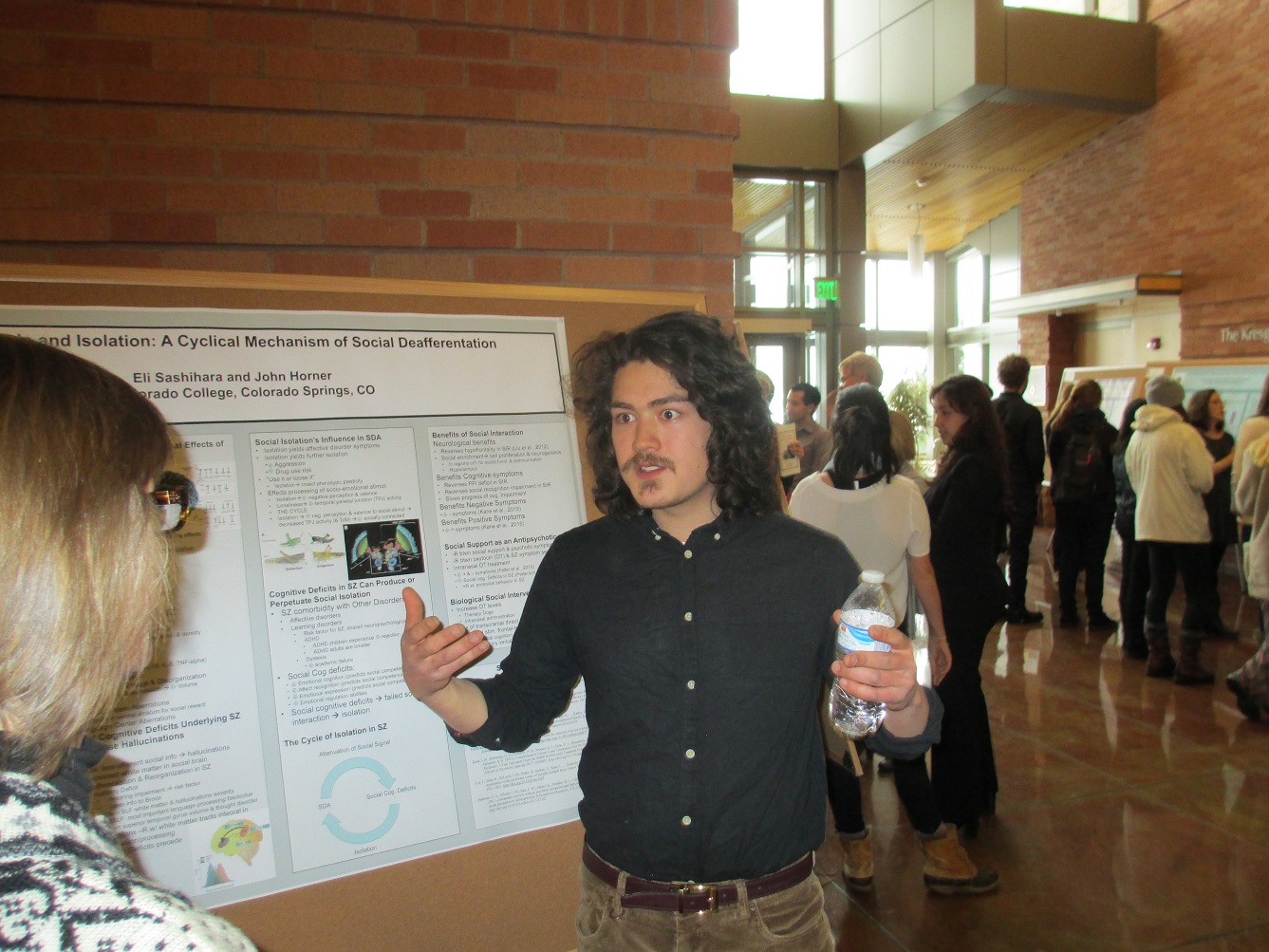
Neuroscience
Advisor: John Horner
Schizophrenia and Isolation: A Cyclical Mechanism of Social Deafferentation
Isolation has been shown to induce social cognitive, neurostructural, behavioral and physiological aberrations mirroring what is observed in schizophrenic (SZ) patients. SZ patients widely report being socially isolated, and research suggests that isolation may be a prodromal symptom of SZ. An attenuation of the neural social network, or social brain, and social cognition is present in first relatives of SZ patients and often before the onset of the illness. This suggests a mechanistic role and interaction between social isolation and social cognitive deficits observed in SZ. Observed epigenetic alterations in gene expression in the brains of SZ individuals further supports the suggestion of social isolation's influence in the pathogenesis of SZ. A cycle of attenuated social stimuli, or social deafferentation, may induce the onset of SZ. In this suggested mechanism, a biological weakening of one's social brain strains relationships and social interactions, fueling social exclusion and isolation. The consequential isolation further perpetuates a deafferentation of social stimuli and complex neurostructural reorganization, decreasing social functioning, general outcome and producing hallucinations. Social support and methods to reduce social cognitive deficits may be an effective mode of treatment in substitution or tandem with medication.
Michael W. Sewell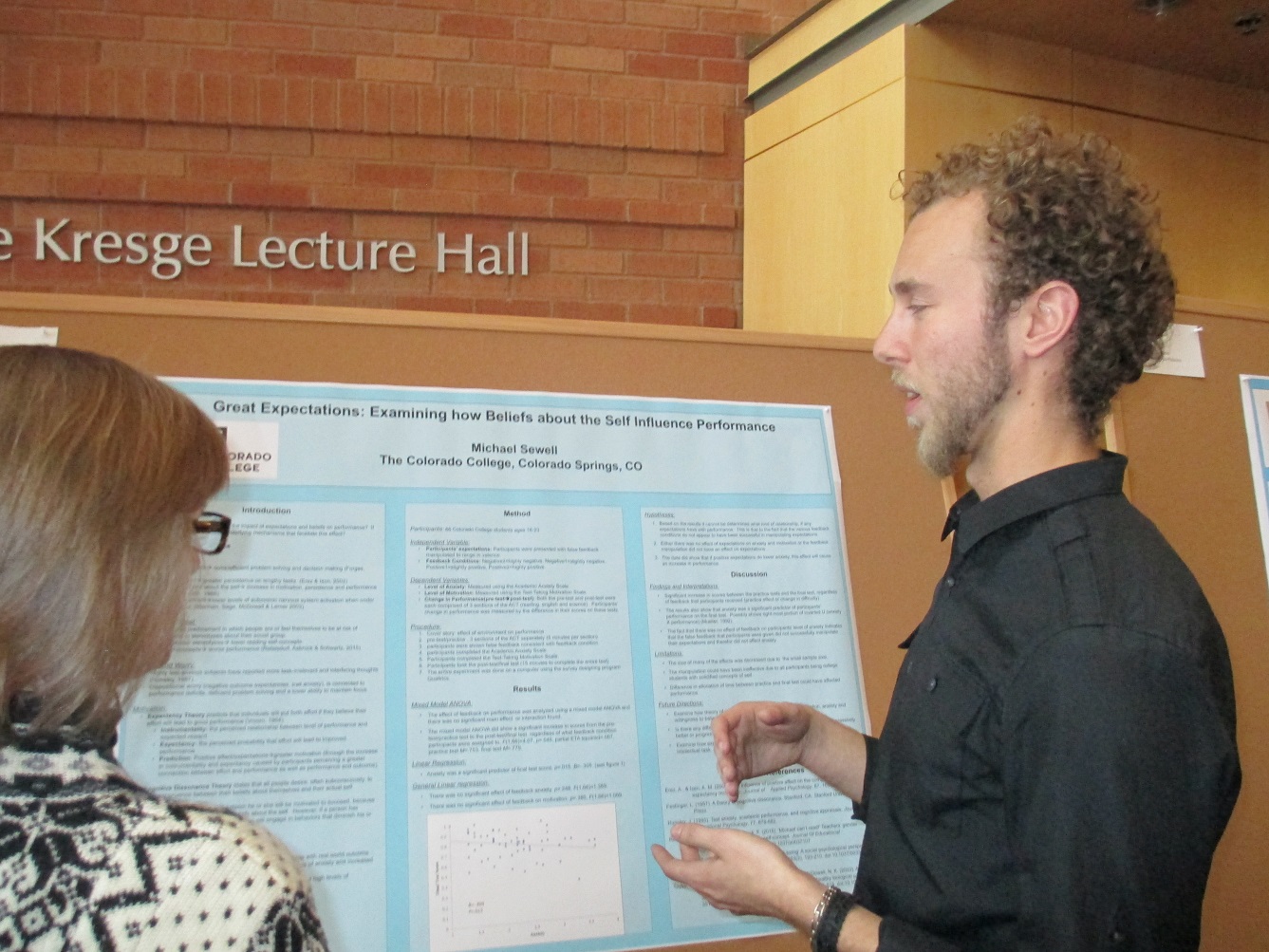
Psychology
Advisor: Jason Weaver
Great Expectations: Examining how Beliefs about the Self Influence Performance
This paper examines the effect of expectations on performance as well as the roles that motivation and anxiety play as potential mediators of this effect. The effect of expectations was examined by giving participants false feedback on 3 practice tests. There were five different feedback conditions, each of which was designed to manipulate participants' expectations for their performance on the final test. Participants were also asked to answer a motivation and an anxiety questionnaire, and finally their scores on the final test were compared to their scores on the pre-manipulation practice tests. The results showed that participants performed better on the final test than the practice tests regardless of what feedback they had received. Anxiety combined with motivation as well as anxiety alone were both shown to be significant predictors of participants' performance on the final test.
Mackenzie Tennison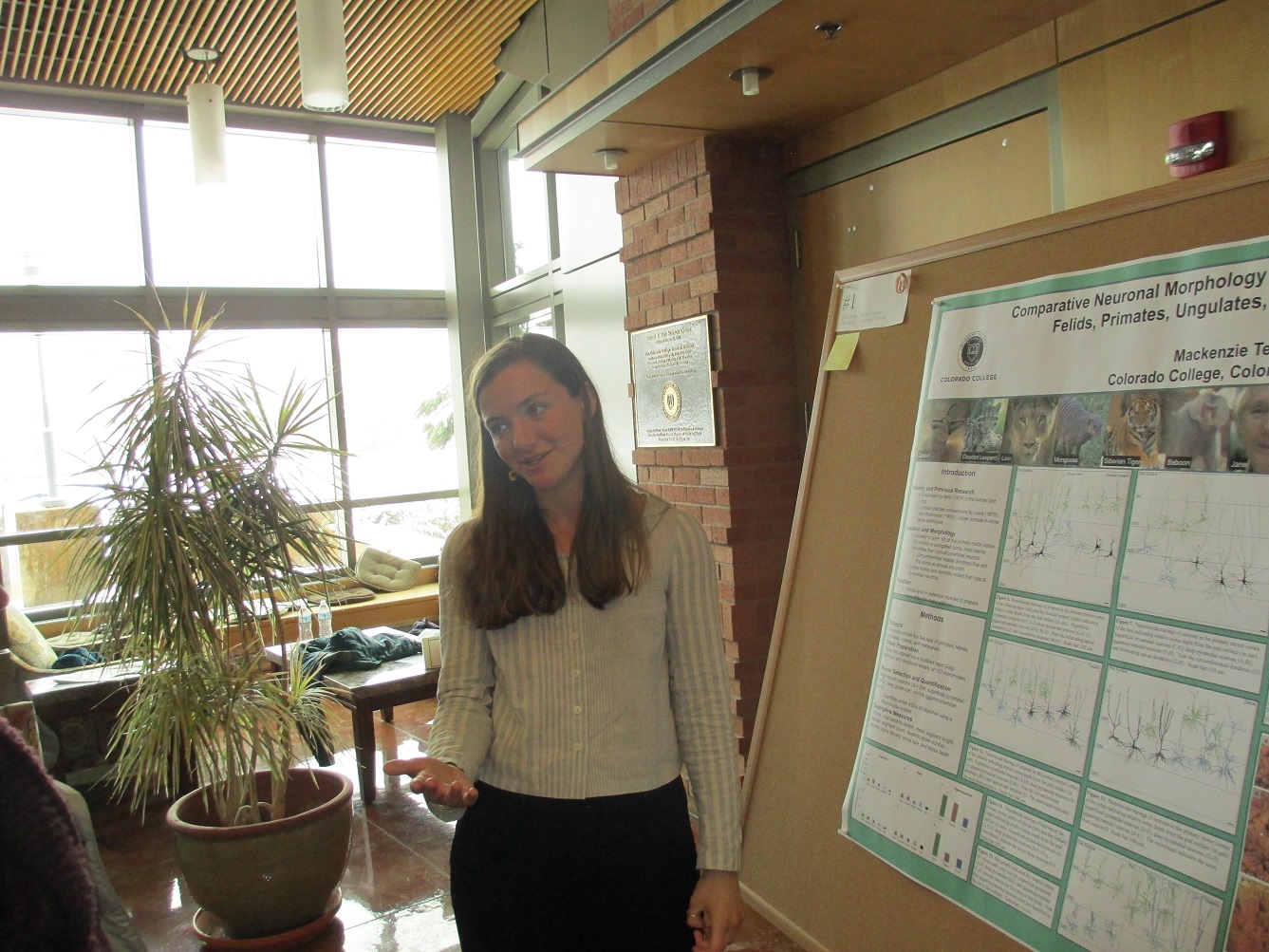
Neuroscience
Advisor: Bob Jacobs
Comparative Neuronal Morphology of Gigantopyramidal Neurons in Felids, Primates, Ungulates, the Wallaby, and the Rat
Although the basic morphological characteristics of gigantopyramidal neurons in the motor cortex have been documented in several species, very little is known about the quantitative characteristics of these neurons across different taxa. To this end, the present study supplements ongoing comparative neuromorphological research by quantitatively exploring gigantopyramidal neurons in the motor cortices of thirteen different species comprising a broad phylogenetic range: felids (caracal, lion, clouded leopard, mongoose, Siberian tiger), primates (baboon, human, golden lion tamarin, ring-tailed lemur), ungulates (giraffe, zebra) the rat, and the wallaby. For comparative purposes, three pyramidal neuron types (e.g. superficial pyramidal, deep pyramidal, and gigantopyramidal; N = 298) were stained with a modified rapid Golgi technique and quantified on a computer-assisted microscopy system. Quantitatively, gigantopyramidal neurons were substantially larger than typical pyramidal neurons and exhibited more numerous basilar dendrites that exited circumferentially from the soma. The largest gigantopyramidal somata were exhibited by the felids, which confirms the preliminary observation of Brodmann (1909) that these neurons are particularly large in carnivores. Qualitatively, there was considerable interspecific variation, particularly for the ungulates, whose neurons exhibited widely bifurcating V-shaped apical dendrites. The observed taxonomic variation suggests that gigantopyramidal neurons may increase the speed of quick, coordinated movements (e.g., pouncing behavior), although comparison of neuronal morphology in a more numerous and diverse collection of species may further elucidate their function.
Tia A. Tummino
Neuroscience
Advisor: Lori Driscoll
Bifidobacterium infantis Supplementation Alters the Development of Adolescent Rat Anxiety with Sex-Dependent Differences in Vagal Dependency
The importance of commensal gut bacteria in shaping nervous system structure and function is becoming increasingly evident. However, the extent to which effects of gut bacteria on the brain are mediated through immune, hormonal, and/or neural (i.e., through the vagus nerve) communication is poorly understood. The purpose of the current study was to elucidate the effects of oral supplementation of the probiotic Bifidobacterium infantis on the development of anxiety and depression in healthy adolescent rats, and to explore the unique contribution of the vagus nerve to such effects. As weanlings, rats were subjected to either a lower transection of the vagus nerve or a sham surgery and were then supplemented daily with B. infantis or vehicle. B. infantis treatment decreased anxious behavior as measured by the elevated plus maze (EPM) in a vagally-dependent manner for male rats and in a vagally-independent manner for female rats. In contrast, neither probiotic supplementation nor vagotomy altered depressive behaviors as measured by the forced swim test (FST). These results suggest that the vagus nerve plays a necessary role in anxiolytic communication between gut B. infantis and the central nervous system (CNS) in male rats, but that other pathways, immune or otherwise, are sufficient to communicate the beneficial effects of B. infantis in females. More research is warranted to further disentangle the pathways utilized by commensal gut bacteria in shaping healthy neurobehavioral function, as well as the therapeutic benefits that result from dietary probiotic supplementation.
Molly Winston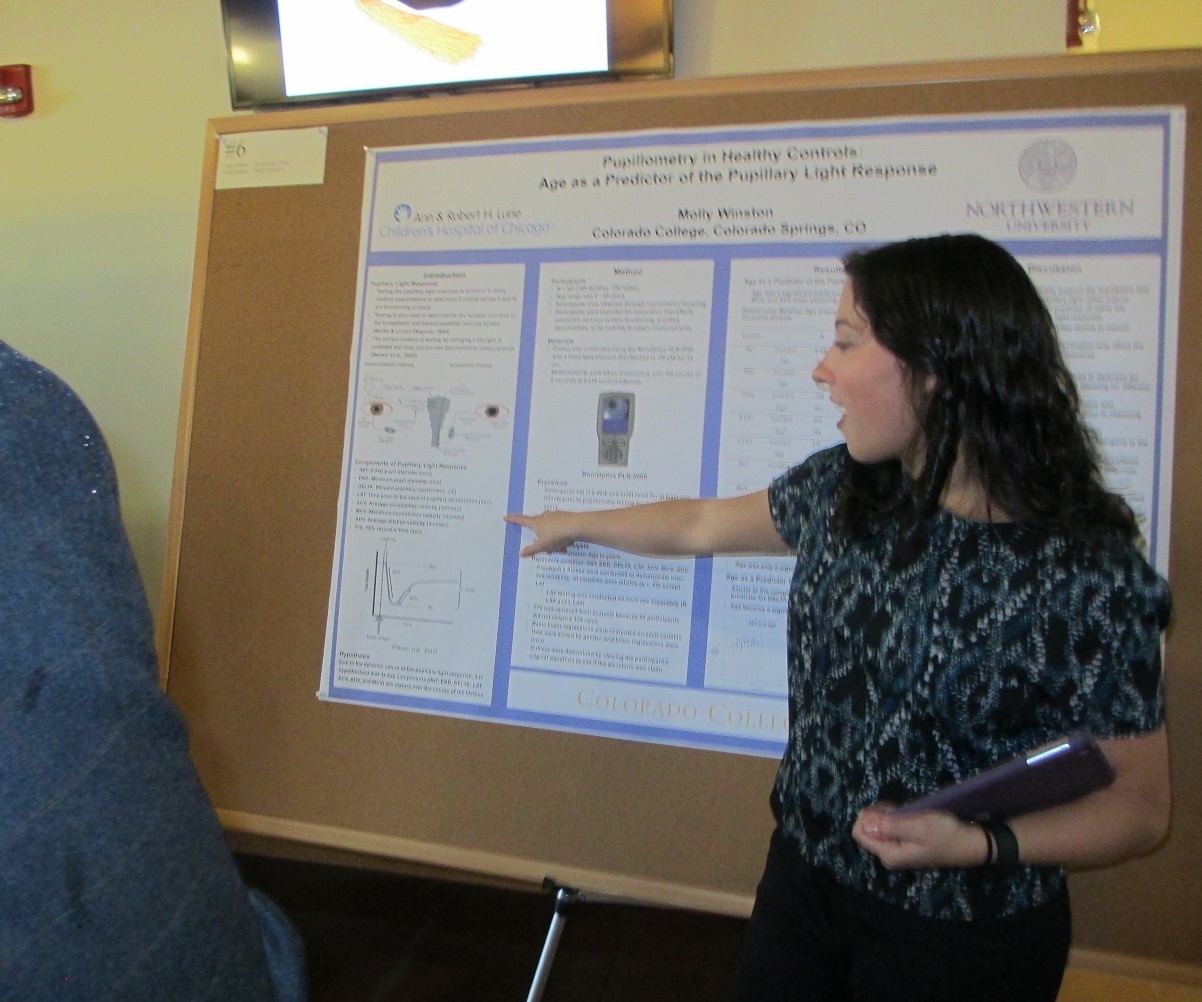
Neuroscience
Advisor: Bob Jacobs, Debra Weese-Mayer
Pupillometry in Healthy Controls: Age as a Predictor of the Pupillary Light Response
Pupillometry as a diagnostic tool has large implications for those suffering from traumatic brain injuries or any disorder that affects the autonomic nervous system. It is a non-invasive, objective method that enables medical professionals to view the relationship between sympathetic and parasympathetic tone in a patient's autonomic nervous system. In order to quantitatively understand the qualitative differences seen in those with autonomic dysregulation it is imperative to elucidate the trends of the pupillary light reflex in healthy controls. The present study explores the relationship between each of the components of the pupillary light reflex, given by the NeurOptics PLR-2000, and age. Additionally, the present study examines if this relationship varies by gender. The results of linear regression analysis on the complete dataset indicate that age is a significant predictor for ACV, MCV, ADV, DELTA, and LAT in the right eye. However, when the dataset is separated by gender, age as a predictor varies. For females age is only a significantly predictor for LAT in the right eye, whereas in males age is a significant predictor for DELTA, MCV, ADV, INIT, and END. Overall, the present study demonstrates the importance of viewing the pupillary light reflex as a dynamic reflex for its clinical applications. It also calls for future research in order to further explore gender differences and elucidate how the autonomic nervous system, and pupillary light reflex, develops.
show all / hide all


